Interpersonal Communication Theories and Applications
VerifiedAdded on 2020/05/28
|23
|5393
|112
AI Summary
This assignment delves into the realm of interpersonal communication, examining prominent theories that shape our interactions. It explores social and cognitive approaches to understanding communication dynamics, highlighting the importance of effective communication skills in various settings like healthcare and education. The analysis includes studies on patient-provider communication, multidisciplinary collaboration, and crisis communication strategies. Furthermore, it discusses models for improving interpersonal communication, such as the Johari Window, and their impact on managerial effectiveness.
Contribute Materials
Your contribution can guide someone’s learning journey. Share your
documents today.

Running head: REFLECTIVE ANALYSIS ON COMMUNICATING METHODS
REFLECTIVE ANALYSIS ON COMMUNICATING METHODS
Name of the Student
Name of the University
Author Note
REFLECTIVE ANALYSIS ON COMMUNICATING METHODS
Name of the Student
Name of the University
Author Note
Secure Best Marks with AI Grader
Need help grading? Try our AI Grader for instant feedback on your assignments.
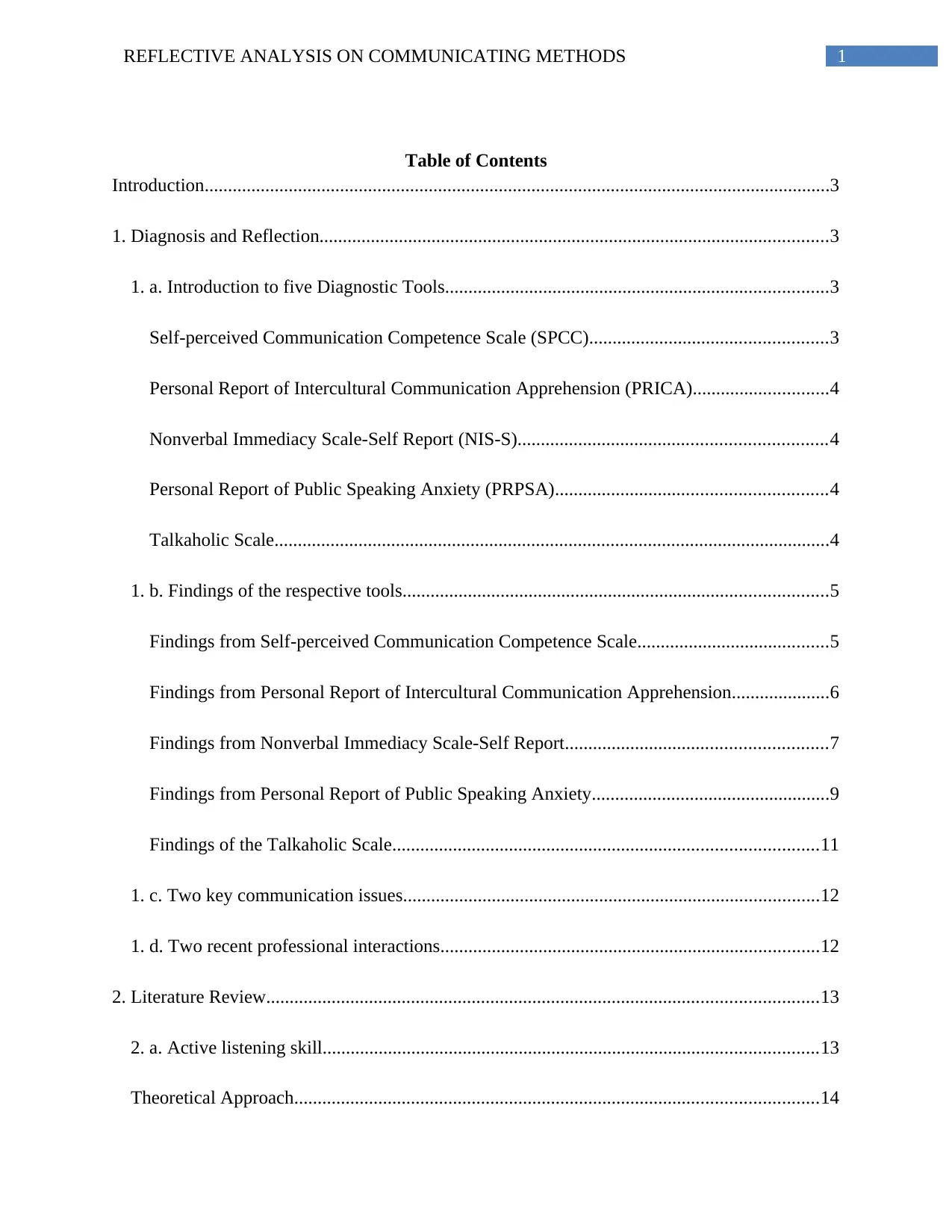
1REFLECTIVE ANALYSIS ON COMMUNICATING METHODS
Table of Contents
Introduction......................................................................................................................................3
1. Diagnosis and Reflection.............................................................................................................3
1. a. Introduction to five Diagnostic Tools..................................................................................3
Self-perceived Communication Competence Scale (SPCC)...................................................3
Personal Report of Intercultural Communication Apprehension (PRICA).............................4
Nonverbal Immediacy Scale-Self Report (NIS-S)..................................................................4
Personal Report of Public Speaking Anxiety (PRPSA)..........................................................4
Talkaholic Scale.......................................................................................................................4
1. b. Findings of the respective tools...........................................................................................5
Findings from Self-perceived Communication Competence Scale.........................................5
Findings from Personal Report of Intercultural Communication Apprehension.....................6
Findings from Nonverbal Immediacy Scale-Self Report........................................................7
Findings from Personal Report of Public Speaking Anxiety...................................................9
Findings of the Talkaholic Scale...........................................................................................11
1. c. Two key communication issues.........................................................................................12
1. d. Two recent professional interactions.................................................................................12
2. Literature Review......................................................................................................................13
2. a. Active listening skill..........................................................................................................13
Theoretical Approach................................................................................................................14
Table of Contents
Introduction......................................................................................................................................3
1. Diagnosis and Reflection.............................................................................................................3
1. a. Introduction to five Diagnostic Tools..................................................................................3
Self-perceived Communication Competence Scale (SPCC)...................................................3
Personal Report of Intercultural Communication Apprehension (PRICA).............................4
Nonverbal Immediacy Scale-Self Report (NIS-S)..................................................................4
Personal Report of Public Speaking Anxiety (PRPSA)..........................................................4
Talkaholic Scale.......................................................................................................................4
1. b. Findings of the respective tools...........................................................................................5
Findings from Self-perceived Communication Competence Scale.........................................5
Findings from Personal Report of Intercultural Communication Apprehension.....................6
Findings from Nonverbal Immediacy Scale-Self Report........................................................7
Findings from Personal Report of Public Speaking Anxiety...................................................9
Findings of the Talkaholic Scale...........................................................................................11
1. c. Two key communication issues.........................................................................................12
1. d. Two recent professional interactions.................................................................................12
2. Literature Review......................................................................................................................13
2. a. Active listening skill..........................................................................................................13
Theoretical Approach................................................................................................................14
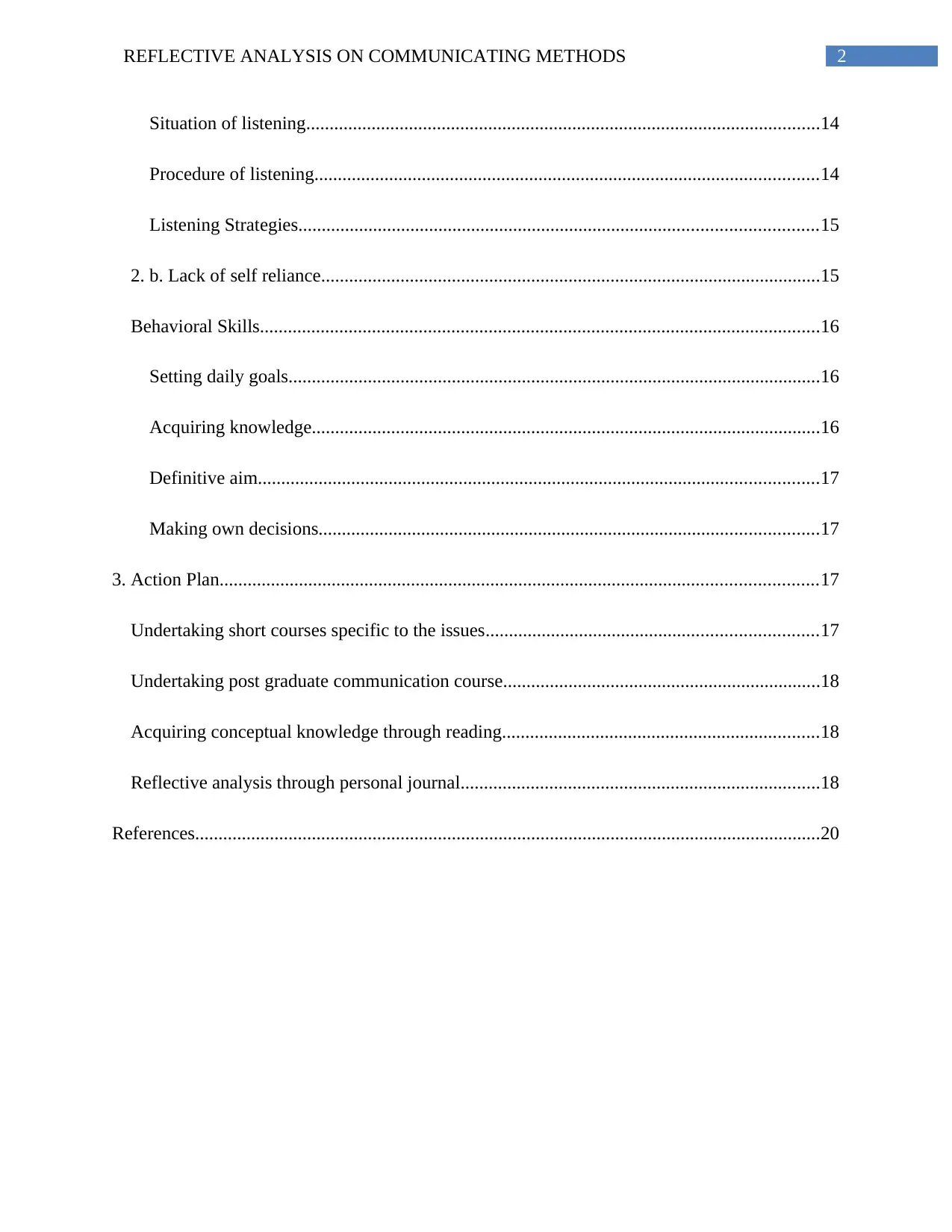
2REFLECTIVE ANALYSIS ON COMMUNICATING METHODS
Situation of listening..............................................................................................................14
Procedure of listening............................................................................................................14
Listening Strategies...............................................................................................................15
2. b. Lack of self reliance...........................................................................................................15
Behavioral Skills........................................................................................................................16
Setting daily goals..................................................................................................................16
Acquiring knowledge.............................................................................................................16
Definitive aim........................................................................................................................17
Making own decisions...........................................................................................................17
3. Action Plan................................................................................................................................17
Undertaking short courses specific to the issues.......................................................................17
Undertaking post graduate communication course....................................................................18
Acquiring conceptual knowledge through reading....................................................................18
Reflective analysis through personal journal.............................................................................18
References......................................................................................................................................20
Situation of listening..............................................................................................................14
Procedure of listening............................................................................................................14
Listening Strategies...............................................................................................................15
2. b. Lack of self reliance...........................................................................................................15
Behavioral Skills........................................................................................................................16
Setting daily goals..................................................................................................................16
Acquiring knowledge.............................................................................................................16
Definitive aim........................................................................................................................17
Making own decisions...........................................................................................................17
3. Action Plan................................................................................................................................17
Undertaking short courses specific to the issues.......................................................................17
Undertaking post graduate communication course....................................................................18
Acquiring conceptual knowledge through reading....................................................................18
Reflective analysis through personal journal.............................................................................18
References......................................................................................................................................20
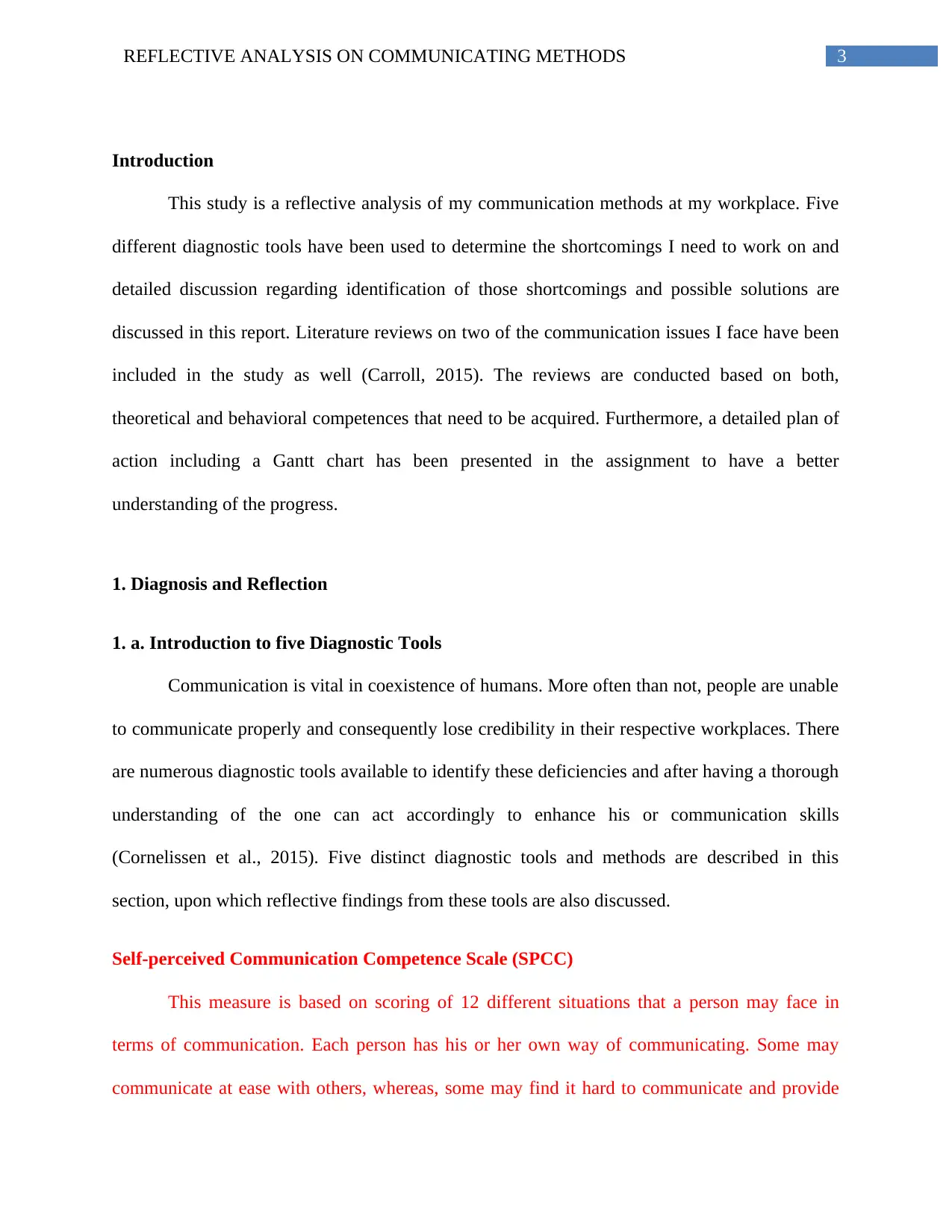
3REFLECTIVE ANALYSIS ON COMMUNICATING METHODS
Introduction
This study is a reflective analysis of my communication methods at my workplace. Five
different diagnostic tools have been used to determine the shortcomings I need to work on and
detailed discussion regarding identification of those shortcomings and possible solutions are
discussed in this report. Literature reviews on two of the communication issues I face have been
included in the study as well (Carroll, 2015). The reviews are conducted based on both,
theoretical and behavioral competences that need to be acquired. Furthermore, a detailed plan of
action including a Gantt chart has been presented in the assignment to have a better
understanding of the progress.
1. Diagnosis and Reflection
1. a. Introduction to five Diagnostic Tools
Communication is vital in coexistence of humans. More often than not, people are unable
to communicate properly and consequently lose credibility in their respective workplaces. There
are numerous diagnostic tools available to identify these deficiencies and after having a thorough
understanding of the one can act accordingly to enhance his or communication skills
(Cornelissen et al., 2015). Five distinct diagnostic tools and methods are described in this
section, upon which reflective findings from these tools are also discussed.
Self-perceived Communication Competence Scale (SPCC)
This measure is based on scoring of 12 different situations that a person may face in
terms of communication. Each person has his or her own way of communicating. Some may
communicate at ease with others, whereas, some may find it hard to communicate and provide
Introduction
This study is a reflective analysis of my communication methods at my workplace. Five
different diagnostic tools have been used to determine the shortcomings I need to work on and
detailed discussion regarding identification of those shortcomings and possible solutions are
discussed in this report. Literature reviews on two of the communication issues I face have been
included in the study as well (Carroll, 2015). The reviews are conducted based on both,
theoretical and behavioral competences that need to be acquired. Furthermore, a detailed plan of
action including a Gantt chart has been presented in the assignment to have a better
understanding of the progress.
1. Diagnosis and Reflection
1. a. Introduction to five Diagnostic Tools
Communication is vital in coexistence of humans. More often than not, people are unable
to communicate properly and consequently lose credibility in their respective workplaces. There
are numerous diagnostic tools available to identify these deficiencies and after having a thorough
understanding of the one can act accordingly to enhance his or communication skills
(Cornelissen et al., 2015). Five distinct diagnostic tools and methods are described in this
section, upon which reflective findings from these tools are also discussed.
Self-perceived Communication Competence Scale (SPCC)
This measure is based on scoring of 12 different situations that a person may face in
terms of communication. Each person has his or her own way of communicating. Some may
communicate at ease with others, whereas, some may find it hard to communicate and provide
Secure Best Marks with AI Grader
Need help grading? Try our AI Grader for instant feedback on your assignments.
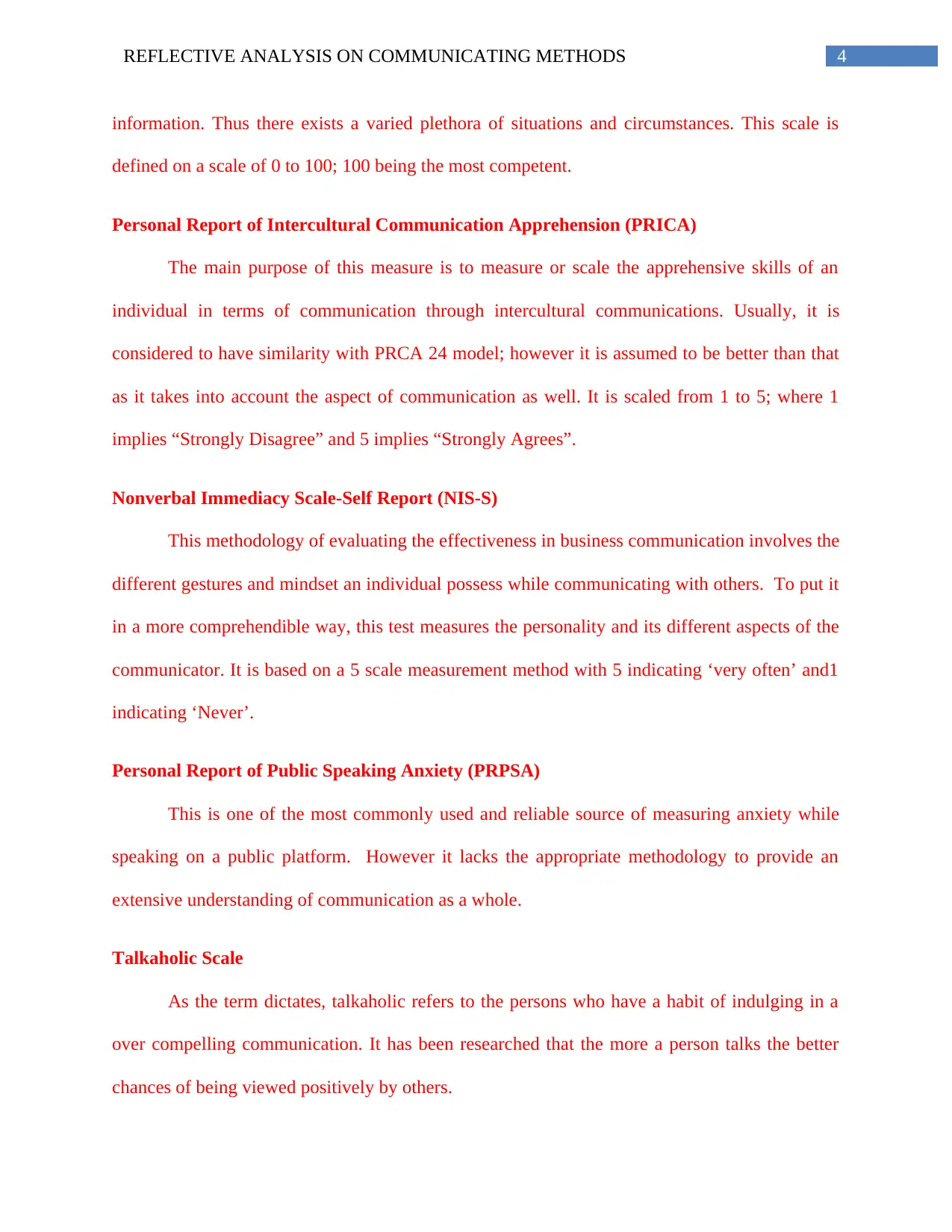
4REFLECTIVE ANALYSIS ON COMMUNICATING METHODS
information. Thus there exists a varied plethora of situations and circumstances. This scale is
defined on a scale of 0 to 100; 100 being the most competent.
Personal Report of Intercultural Communication Apprehension (PRICA)
The main purpose of this measure is to measure or scale the apprehensive skills of an
individual in terms of communication through intercultural communications. Usually, it is
considered to have similarity with PRCA 24 model; however it is assumed to be better than that
as it takes into account the aspect of communication as well. It is scaled from 1 to 5; where 1
implies “Strongly Disagree” and 5 implies “Strongly Agrees”.
Nonverbal Immediacy Scale-Self Report (NIS-S)
This methodology of evaluating the effectiveness in business communication involves the
different gestures and mindset an individual possess while communicating with others. To put it
in a more comprehendible way, this test measures the personality and its different aspects of the
communicator. It is based on a 5 scale measurement method with 5 indicating ‘very often’ and1
indicating ‘Never’.
Personal Report of Public Speaking Anxiety (PRPSA)
This is one of the most commonly used and reliable source of measuring anxiety while
speaking on a public platform. However it lacks the appropriate methodology to provide an
extensive understanding of communication as a whole.
Talkaholic Scale
As the term dictates, talkaholic refers to the persons who have a habit of indulging in a
over compelling communication. It has been researched that the more a person talks the better
chances of being viewed positively by others.
information. Thus there exists a varied plethora of situations and circumstances. This scale is
defined on a scale of 0 to 100; 100 being the most competent.
Personal Report of Intercultural Communication Apprehension (PRICA)
The main purpose of this measure is to measure or scale the apprehensive skills of an
individual in terms of communication through intercultural communications. Usually, it is
considered to have similarity with PRCA 24 model; however it is assumed to be better than that
as it takes into account the aspect of communication as well. It is scaled from 1 to 5; where 1
implies “Strongly Disagree” and 5 implies “Strongly Agrees”.
Nonverbal Immediacy Scale-Self Report (NIS-S)
This methodology of evaluating the effectiveness in business communication involves the
different gestures and mindset an individual possess while communicating with others. To put it
in a more comprehendible way, this test measures the personality and its different aspects of the
communicator. It is based on a 5 scale measurement method with 5 indicating ‘very often’ and1
indicating ‘Never’.
Personal Report of Public Speaking Anxiety (PRPSA)
This is one of the most commonly used and reliable source of measuring anxiety while
speaking on a public platform. However it lacks the appropriate methodology to provide an
extensive understanding of communication as a whole.
Talkaholic Scale
As the term dictates, talkaholic refers to the persons who have a habit of indulging in a
over compelling communication. It has been researched that the more a person talks the better
chances of being viewed positively by others.
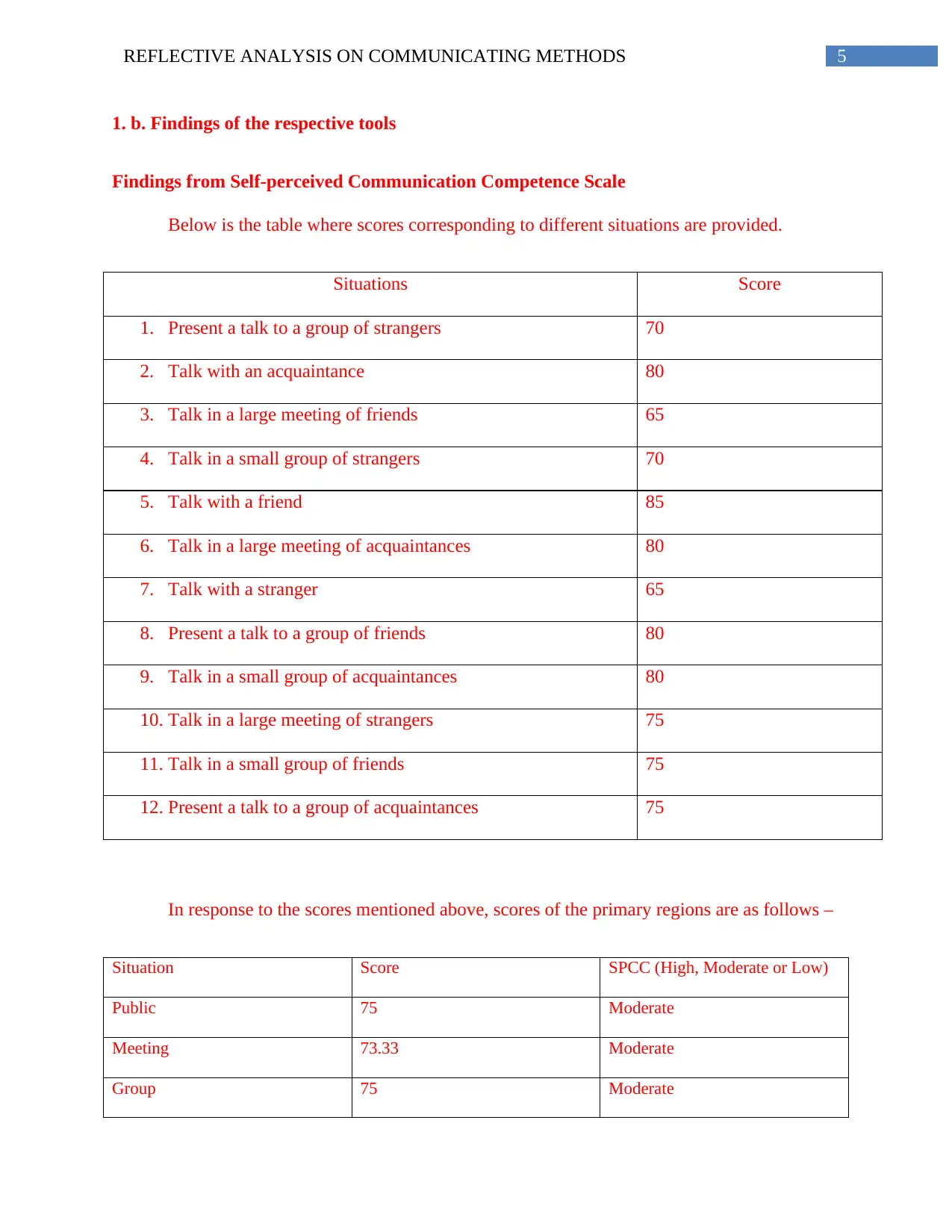
5REFLECTIVE ANALYSIS ON COMMUNICATING METHODS
1. b. Findings of the respective tools
Findings from Self-perceived Communication Competence Scale
Below is the table where scores corresponding to different situations are provided.
Situations Score
1. Present a talk to a group of strangers 70
2. Talk with an acquaintance 80
3. Talk in a large meeting of friends 65
4. Talk in a small group of strangers 70
5. Talk with a friend 85
6. Talk in a large meeting of acquaintances 80
7. Talk with a stranger 65
8. Present a talk to a group of friends 80
9. Talk in a small group of acquaintances 80
10. Talk in a large meeting of strangers 75
11. Talk in a small group of friends 75
12. Present a talk to a group of acquaintances 75
In response to the scores mentioned above, scores of the primary regions are as follows –
Situation Score SPCC (High, Moderate or Low)
Public 75 Moderate
Meeting 73.33 Moderate
Group 75 Moderate
1. b. Findings of the respective tools
Findings from Self-perceived Communication Competence Scale
Below is the table where scores corresponding to different situations are provided.
Situations Score
1. Present a talk to a group of strangers 70
2. Talk with an acquaintance 80
3. Talk in a large meeting of friends 65
4. Talk in a small group of strangers 70
5. Talk with a friend 85
6. Talk in a large meeting of acquaintances 80
7. Talk with a stranger 65
8. Present a talk to a group of friends 80
9. Talk in a small group of acquaintances 80
10. Talk in a large meeting of strangers 75
11. Talk in a small group of friends 75
12. Present a talk to a group of acquaintances 75
In response to the scores mentioned above, scores of the primary regions are as follows –
Situation Score SPCC (High, Moderate or Low)
Public 75 Moderate
Meeting 73.33 Moderate
Group 75 Moderate
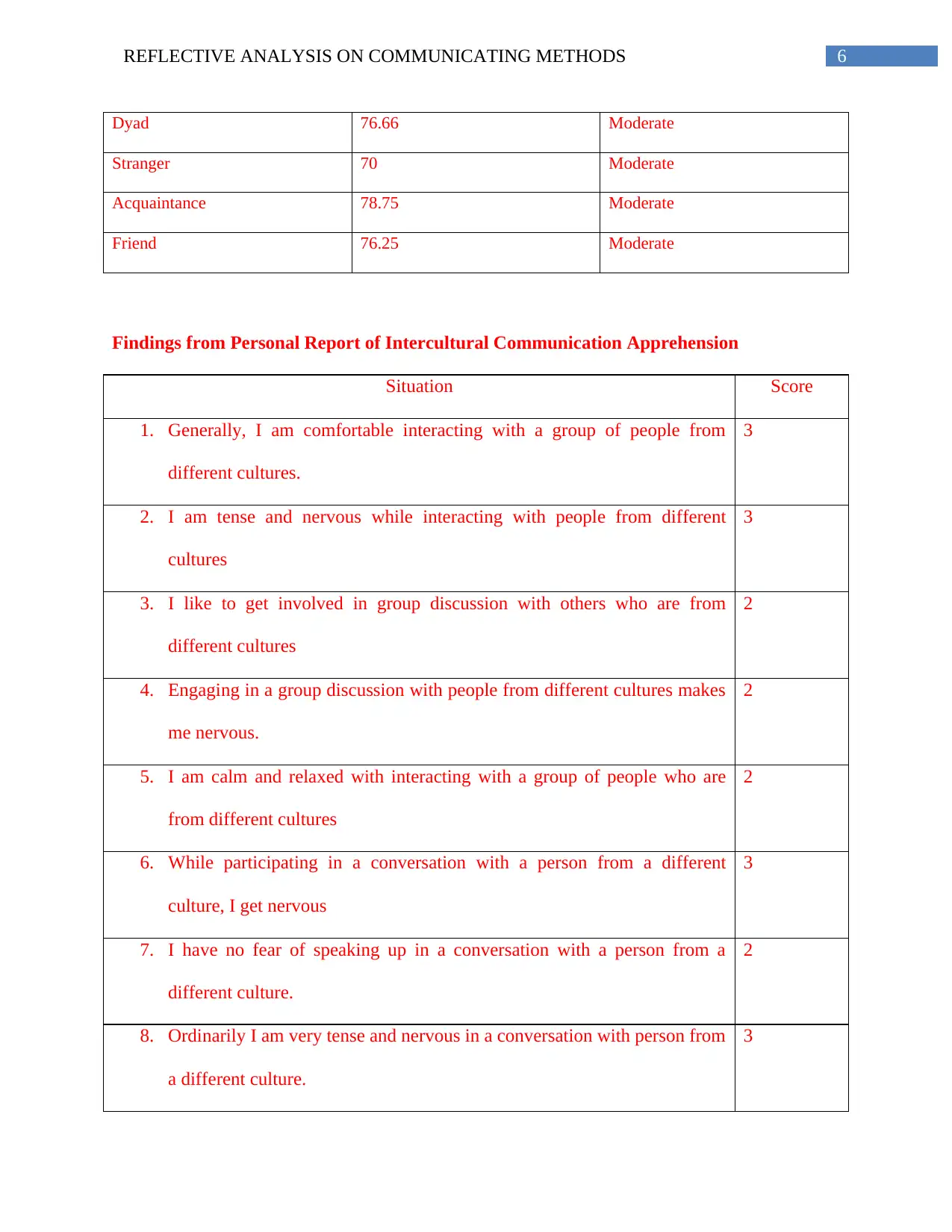
6REFLECTIVE ANALYSIS ON COMMUNICATING METHODS
Dyad 76.66 Moderate
Stranger 70 Moderate
Acquaintance 78.75 Moderate
Friend 76.25 Moderate
Findings from Personal Report of Intercultural Communication Apprehension
Situation Score
1. Generally, I am comfortable interacting with a group of people from
different cultures.
3
2. I am tense and nervous while interacting with people from different
cultures
3
3. I like to get involved in group discussion with others who are from
different cultures
2
4. Engaging in a group discussion with people from different cultures makes
me nervous.
2
5. I am calm and relaxed with interacting with a group of people who are
from different cultures
2
6. While participating in a conversation with a person from a different
culture, I get nervous
3
7. I have no fear of speaking up in a conversation with a person from a
different culture.
2
8. Ordinarily I am very tense and nervous in a conversation with person from
a different culture.
3
Dyad 76.66 Moderate
Stranger 70 Moderate
Acquaintance 78.75 Moderate
Friend 76.25 Moderate
Findings from Personal Report of Intercultural Communication Apprehension
Situation Score
1. Generally, I am comfortable interacting with a group of people from
different cultures.
3
2. I am tense and nervous while interacting with people from different
cultures
3
3. I like to get involved in group discussion with others who are from
different cultures
2
4. Engaging in a group discussion with people from different cultures makes
me nervous.
2
5. I am calm and relaxed with interacting with a group of people who are
from different cultures
2
6. While participating in a conversation with a person from a different
culture, I get nervous
3
7. I have no fear of speaking up in a conversation with a person from a
different culture.
2
8. Ordinarily I am very tense and nervous in a conversation with person from
a different culture.
3
Paraphrase This Document
Need a fresh take? Get an instant paraphrase of this document with our AI Paraphraser
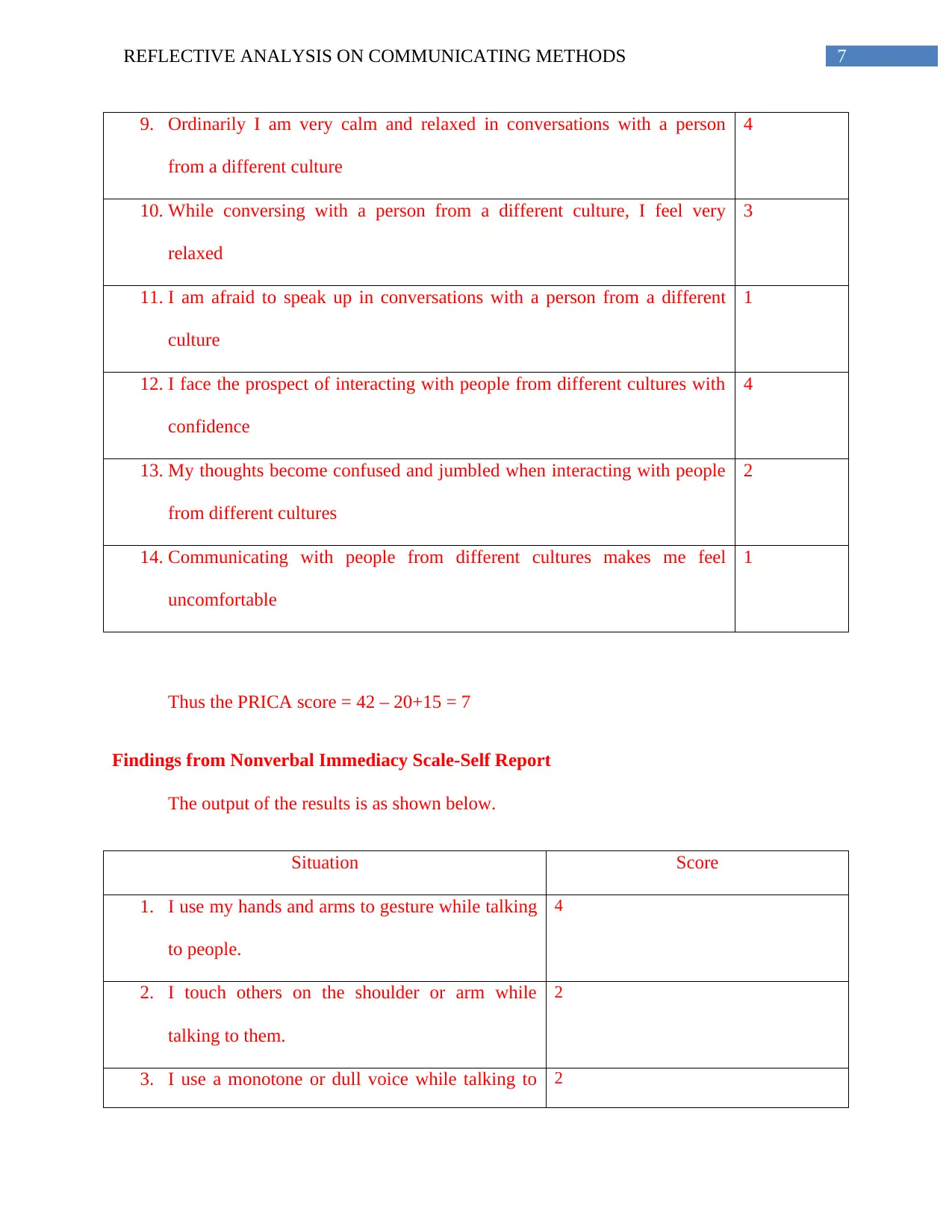
7REFLECTIVE ANALYSIS ON COMMUNICATING METHODS
9. Ordinarily I am very calm and relaxed in conversations with a person
from a different culture
4
10. While conversing with a person from a different culture, I feel very
relaxed
3
11. I am afraid to speak up in conversations with a person from a different
culture
1
12. I face the prospect of interacting with people from different cultures with
confidence
4
13. My thoughts become confused and jumbled when interacting with people
from different cultures
2
14. Communicating with people from different cultures makes me feel
uncomfortable
1
Thus the PRICA score = 42 – 20+15 = 7
Findings from Nonverbal Immediacy Scale-Self Report
The output of the results is as shown below.
Situation Score
1. I use my hands and arms to gesture while talking
to people.
4
2. I touch others on the shoulder or arm while
talking to them.
2
3. I use a monotone or dull voice while talking to 2
9. Ordinarily I am very calm and relaxed in conversations with a person
from a different culture
4
10. While conversing with a person from a different culture, I feel very
relaxed
3
11. I am afraid to speak up in conversations with a person from a different
culture
1
12. I face the prospect of interacting with people from different cultures with
confidence
4
13. My thoughts become confused and jumbled when interacting with people
from different cultures
2
14. Communicating with people from different cultures makes me feel
uncomfortable
1
Thus the PRICA score = 42 – 20+15 = 7
Findings from Nonverbal Immediacy Scale-Self Report
The output of the results is as shown below.
Situation Score
1. I use my hands and arms to gesture while talking
to people.
4
2. I touch others on the shoulder or arm while
talking to them.
2
3. I use a monotone or dull voice while talking to 2
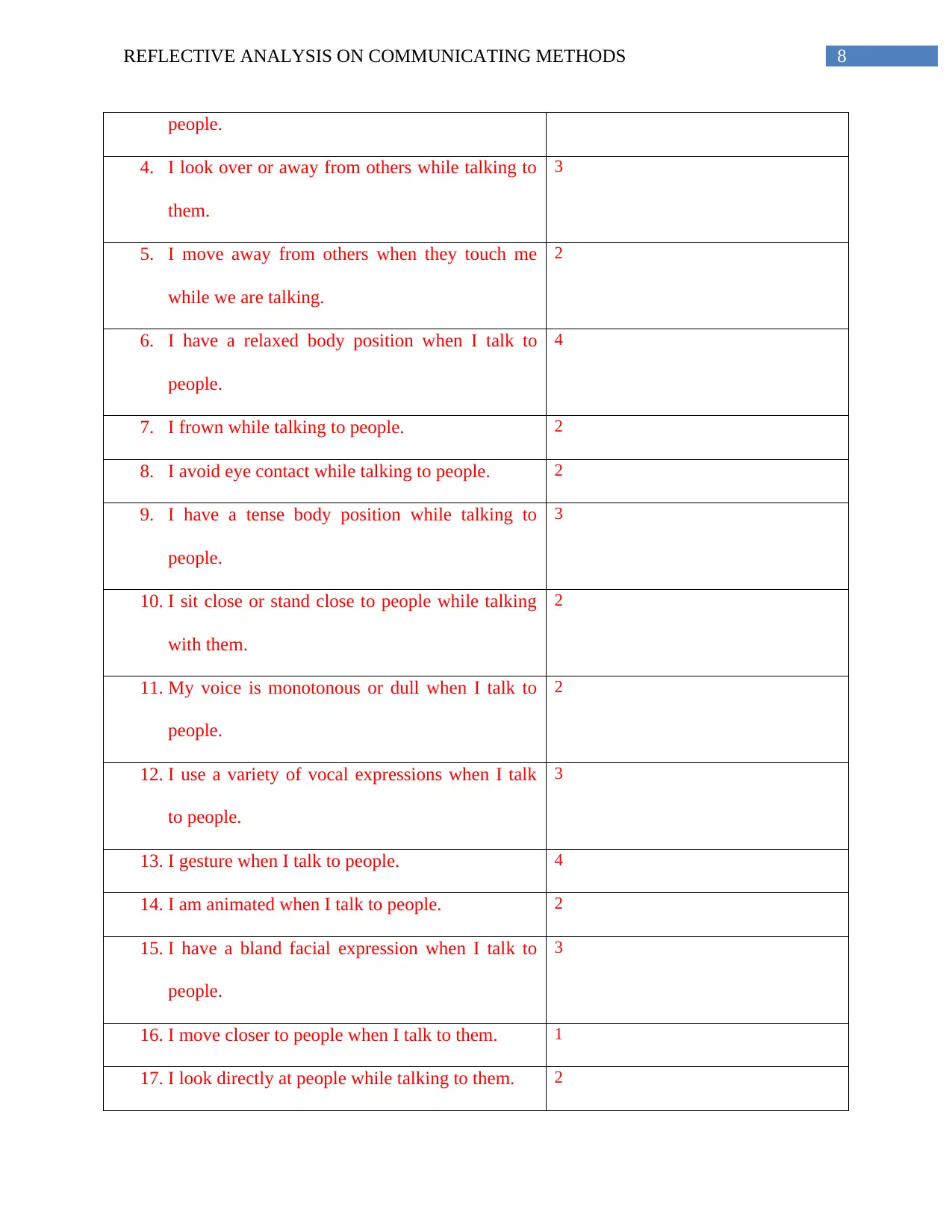
8REFLECTIVE ANALYSIS ON COMMUNICATING METHODS
people.
4. I look over or away from others while talking to
them.
3
5. I move away from others when they touch me
while we are talking.
2
6. I have a relaxed body position when I talk to
people.
4
7. I frown while talking to people. 2
8. I avoid eye contact while talking to people. 2
9. I have a tense body position while talking to
people.
3
10. I sit close or stand close to people while talking
with them.
2
11. My voice is monotonous or dull when I talk to
people.
2
12. I use a variety of vocal expressions when I talk
to people.
3
13. I gesture when I talk to people. 4
14. I am animated when I talk to people. 2
15. I have a bland facial expression when I talk to
people.
3
16. I move closer to people when I talk to them. 1
17. I look directly at people while talking to them. 2
people.
4. I look over or away from others while talking to
them.
3
5. I move away from others when they touch me
while we are talking.
2
6. I have a relaxed body position when I talk to
people.
4
7. I frown while talking to people. 2
8. I avoid eye contact while talking to people. 2
9. I have a tense body position while talking to
people.
3
10. I sit close or stand close to people while talking
with them.
2
11. My voice is monotonous or dull when I talk to
people.
2
12. I use a variety of vocal expressions when I talk
to people.
3
13. I gesture when I talk to people. 4
14. I am animated when I talk to people. 2
15. I have a bland facial expression when I talk to
people.
3
16. I move closer to people when I talk to them. 1
17. I look directly at people while talking to them. 2
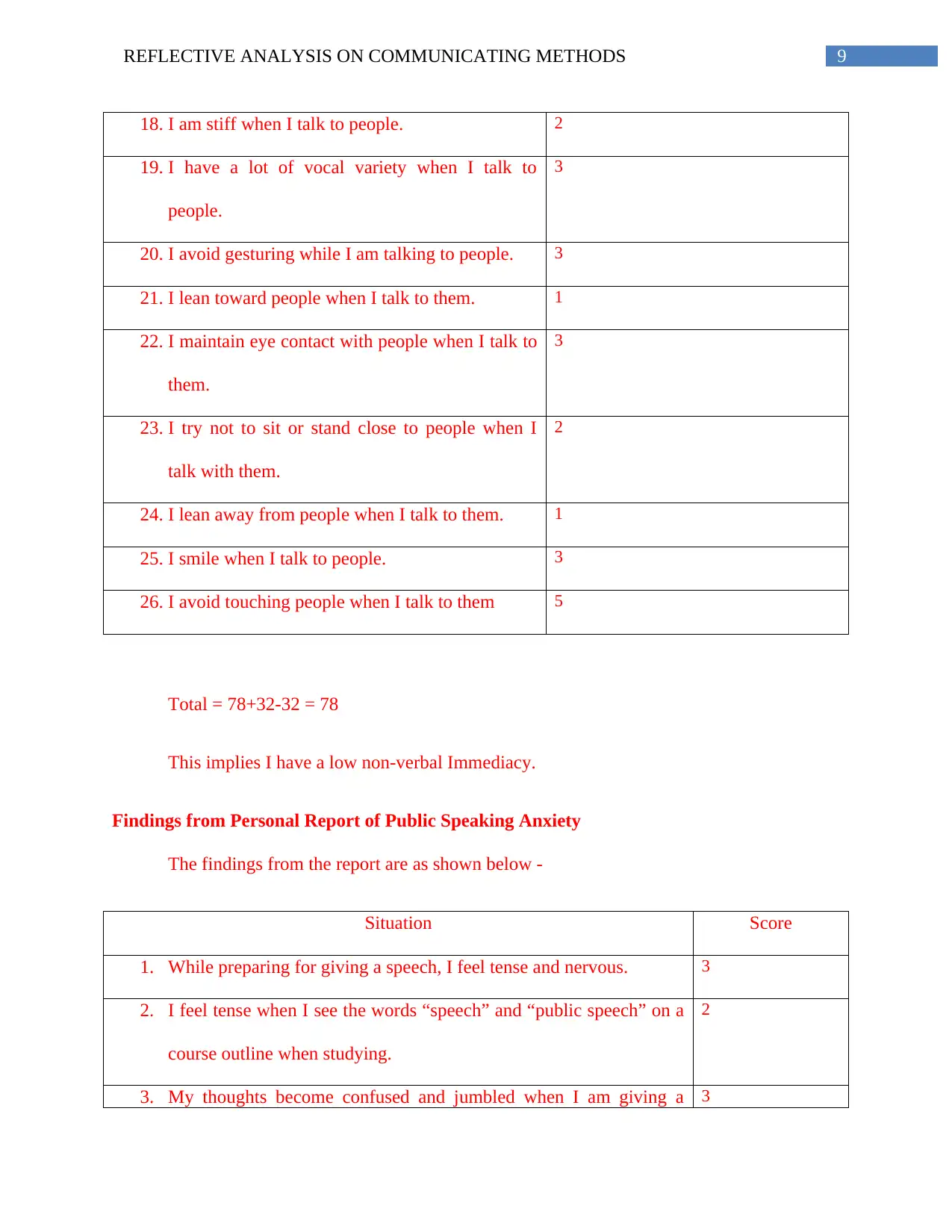
9REFLECTIVE ANALYSIS ON COMMUNICATING METHODS
18. I am stiff when I talk to people. 2
19. I have a lot of vocal variety when I talk to
people.
3
20. I avoid gesturing while I am talking to people. 3
21. I lean toward people when I talk to them. 1
22. I maintain eye contact with people when I talk to
them.
3
23. I try not to sit or stand close to people when I
talk with them.
2
24. I lean away from people when I talk to them. 1
25. I smile when I talk to people. 3
26. I avoid touching people when I talk to them 5
Total = 78+32-32 = 78
This implies I have a low non-verbal Immediacy.
Findings from Personal Report of Public Speaking Anxiety
The findings from the report are as shown below -
Situation Score
1. While preparing for giving a speech, I feel tense and nervous. 3
2. I feel tense when I see the words “speech” and “public speech” on a
course outline when studying.
2
3. My thoughts become confused and jumbled when I am giving a 3
18. I am stiff when I talk to people. 2
19. I have a lot of vocal variety when I talk to
people.
3
20. I avoid gesturing while I am talking to people. 3
21. I lean toward people when I talk to them. 1
22. I maintain eye contact with people when I talk to
them.
3
23. I try not to sit or stand close to people when I
talk with them.
2
24. I lean away from people when I talk to them. 1
25. I smile when I talk to people. 3
26. I avoid touching people when I talk to them 5
Total = 78+32-32 = 78
This implies I have a low non-verbal Immediacy.
Findings from Personal Report of Public Speaking Anxiety
The findings from the report are as shown below -
Situation Score
1. While preparing for giving a speech, I feel tense and nervous. 3
2. I feel tense when I see the words “speech” and “public speech” on a
course outline when studying.
2
3. My thoughts become confused and jumbled when I am giving a 3
Secure Best Marks with AI Grader
Need help grading? Try our AI Grader for instant feedback on your assignments.

10REFLECTIVE ANALYSIS ON COMMUNICATING METHODS
speech
4. Right after giving a speech I feel that I have had a pleasant
experience
4
5. I get anxious when I think about a speech coming up 2
6. I have no fear of giving a speech 3
7. Although I am nervous just before starting a speech, I soon settle
down after starting and feel calm and comfortable
4
8. I look forward to giving a speech 4
9. When the instructor announces a speaking assignment in class, I can
feel myself getting tense
2
10. My hands tremble when I am giving a speech 1
11. I feel relaxed while giving a speech 3
12. I enjoy preparing for a speech. 4
13. I am in constant fear of forgetting what I prepared to say. 2
14. I get anxious if someone asks me something about my topic that I
don’t know.
3
15. I face the prospect of giving a speech with confidence. 4
16. I feel that I am in complete possession of myself while giving a
speech.
3
17. My mind is clear when giving a speech. 3
18. I do not dread giving a speech 3
19. I perspire just before starting a speech. 4
20. My heart beats very fast just as I start a speech 4
21. I experience considerable anxiety while sitting in the room just 2
speech
4. Right after giving a speech I feel that I have had a pleasant
experience
4
5. I get anxious when I think about a speech coming up 2
6. I have no fear of giving a speech 3
7. Although I am nervous just before starting a speech, I soon settle
down after starting and feel calm and comfortable
4
8. I look forward to giving a speech 4
9. When the instructor announces a speaking assignment in class, I can
feel myself getting tense
2
10. My hands tremble when I am giving a speech 1
11. I feel relaxed while giving a speech 3
12. I enjoy preparing for a speech. 4
13. I am in constant fear of forgetting what I prepared to say. 2
14. I get anxious if someone asks me something about my topic that I
don’t know.
3
15. I face the prospect of giving a speech with confidence. 4
16. I feel that I am in complete possession of myself while giving a
speech.
3
17. My mind is clear when giving a speech. 3
18. I do not dread giving a speech 3
19. I perspire just before starting a speech. 4
20. My heart beats very fast just as I start a speech 4
21. I experience considerable anxiety while sitting in the room just 2
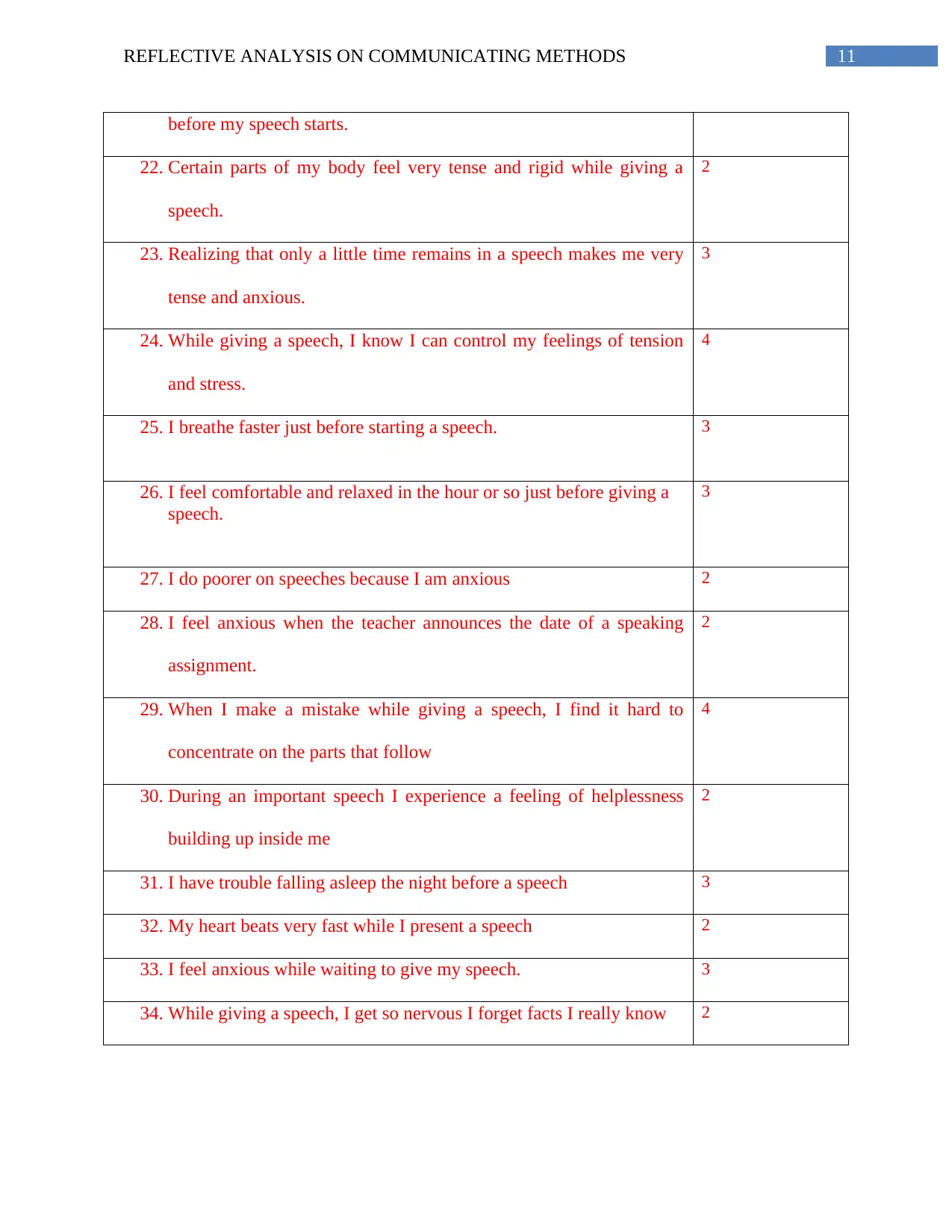
11REFLECTIVE ANALYSIS ON COMMUNICATING METHODS
before my speech starts.
22. Certain parts of my body feel very tense and rigid while giving a
speech.
2
23. Realizing that only a little time remains in a speech makes me very
tense and anxious.
3
24. While giving a speech, I know I can control my feelings of tension
and stress.
4
25. I breathe faster just before starting a speech. 3
26. I feel comfortable and relaxed in the hour or so just before giving a
speech.
3
27. I do poorer on speeches because I am anxious 2
28. I feel anxious when the teacher announces the date of a speaking
assignment.
2
29. When I make a mistake while giving a speech, I find it hard to
concentrate on the parts that follow
4
30. During an important speech I experience a feeling of helplessness
building up inside me
2
31. I have trouble falling asleep the night before a speech 3
32. My heart beats very fast while I present a speech 2
33. I feel anxious while waiting to give my speech. 3
34. While giving a speech, I get so nervous I forget facts I really know 2
before my speech starts.
22. Certain parts of my body feel very tense and rigid while giving a
speech.
2
23. Realizing that only a little time remains in a speech makes me very
tense and anxious.
3
24. While giving a speech, I know I can control my feelings of tension
and stress.
4
25. I breathe faster just before starting a speech. 3
26. I feel comfortable and relaxed in the hour or so just before giving a
speech.
3
27. I do poorer on speeches because I am anxious 2
28. I feel anxious when the teacher announces the date of a speaking
assignment.
2
29. When I make a mistake while giving a speech, I find it hard to
concentrate on the parts that follow
4
30. During an important speech I experience a feeling of helplessness
building up inside me
2
31. I have trouble falling asleep the night before a speech 3
32. My heart beats very fast while I present a speech 2
33. I feel anxious while waiting to give my speech. 3
34. While giving a speech, I get so nervous I forget facts I really know 2
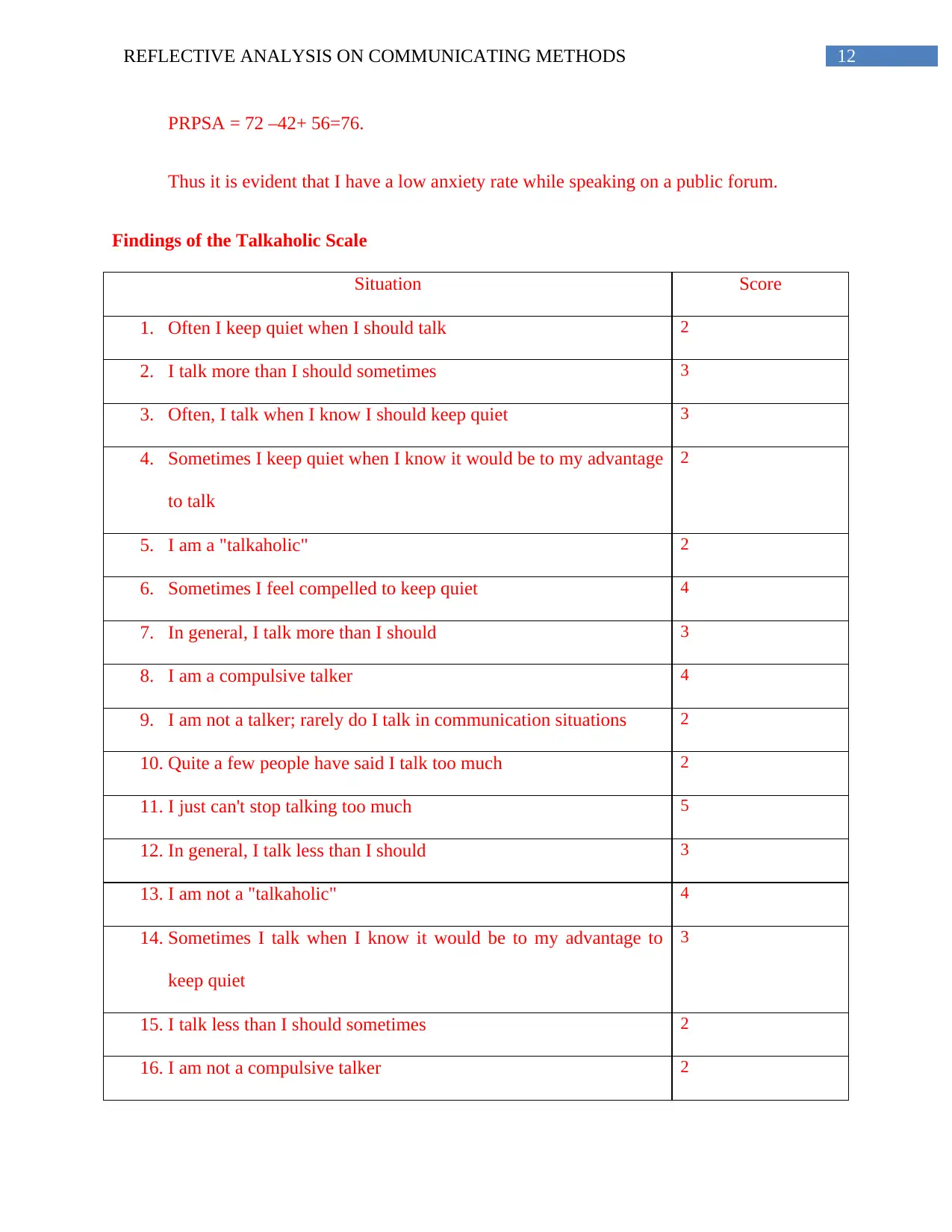
12REFLECTIVE ANALYSIS ON COMMUNICATING METHODS
PRPSA = 72 –42+ 56=76.
Thus it is evident that I have a low anxiety rate while speaking on a public forum.
Findings of the Talkaholic Scale
Situation Score
1. Often I keep quiet when I should talk 2
2. I talk more than I should sometimes 3
3. Often, I talk when I know I should keep quiet 3
4. Sometimes I keep quiet when I know it would be to my advantage
to talk
2
5. I am a "talkaholic" 2
6. Sometimes I feel compelled to keep quiet 4
7. In general, I talk more than I should 3
8. I am a compulsive talker 4
9. I am not a talker; rarely do I talk in communication situations 2
10. Quite a few people have said I talk too much 2
11. I just can't stop talking too much 5
12. In general, I talk less than I should 3
13. I am not a "talkaholic" 4
14. Sometimes I talk when I know it would be to my advantage to
keep quiet
3
15. I talk less than I should sometimes 2
16. I am not a compulsive talker 2
PRPSA = 72 –42+ 56=76.
Thus it is evident that I have a low anxiety rate while speaking on a public forum.
Findings of the Talkaholic Scale
Situation Score
1. Often I keep quiet when I should talk 2
2. I talk more than I should sometimes 3
3. Often, I talk when I know I should keep quiet 3
4. Sometimes I keep quiet when I know it would be to my advantage
to talk
2
5. I am a "talkaholic" 2
6. Sometimes I feel compelled to keep quiet 4
7. In general, I talk more than I should 3
8. I am a compulsive talker 4
9. I am not a talker; rarely do I talk in communication situations 2
10. Quite a few people have said I talk too much 2
11. I just can't stop talking too much 5
12. In general, I talk less than I should 3
13. I am not a "talkaholic" 4
14. Sometimes I talk when I know it would be to my advantage to
keep quiet
3
15. I talk less than I should sometimes 2
16. I am not a compulsive talker 2
Paraphrase This Document
Need a fresh take? Get an instant paraphrase of this document with our AI Paraphraser

13REFLECTIVE ANALYSIS ON COMMUNICATING METHODS
Total Score = 12 + 25-6=31.
It is evident from the score that I am borderline talkaholic. I believe if I can maintain such
a status I would be beneficiary in terms of having a positive response from others.
1. c. Two key communication issues
From the five different diagnostic tools used to diagnose my communication deficiencies,
especially in work places, I identified two issues that I need to work on. The first one is the lack
of focus while listening to others. In technical terms it is referred to as lack of active listening
skills. Active listening requires one to listen with full focus such that majority of the
conversation can be recapitulated later. The second issue is regarding my dependency on others
and team works. I understand that I need to be more self-sufficient, in the sense that I need to
stop over relying on others in cases which I feel I should be working as a group.
1. d. Two recent professional interactions
A couple of months back I had an interaction with the foreign board of inspectors as part
of an orientation course. It was of paramount importance that I learnt and gathered everything
from that interaction program. This is where I realized my active listening issues. I could not
recall majority of the lessons later which even affected my learning process in the job. This also
affects communications as this particular disrupts the flow of a conversation. Not focusing and
listening to what another person is trying to say is a common reason for misunderstandings too.
This makes the other people involved in the conversation irritated and frustrated.
Total Score = 12 + 25-6=31.
It is evident from the score that I am borderline talkaholic. I believe if I can maintain such
a status I would be beneficiary in terms of having a positive response from others.
1. c. Two key communication issues
From the five different diagnostic tools used to diagnose my communication deficiencies,
especially in work places, I identified two issues that I need to work on. The first one is the lack
of focus while listening to others. In technical terms it is referred to as lack of active listening
skills. Active listening requires one to listen with full focus such that majority of the
conversation can be recapitulated later. The second issue is regarding my dependency on others
and team works. I understand that I need to be more self-sufficient, in the sense that I need to
stop over relying on others in cases which I feel I should be working as a group.
1. d. Two recent professional interactions
A couple of months back I had an interaction with the foreign board of inspectors as part
of an orientation course. It was of paramount importance that I learnt and gathered everything
from that interaction program. This is where I realized my active listening issues. I could not
recall majority of the lessons later which even affected my learning process in the job. This also
affects communications as this particular disrupts the flow of a conversation. Not focusing and
listening to what another person is trying to say is a common reason for misunderstandings too.
This makes the other people involved in the conversation irritated and frustrated.
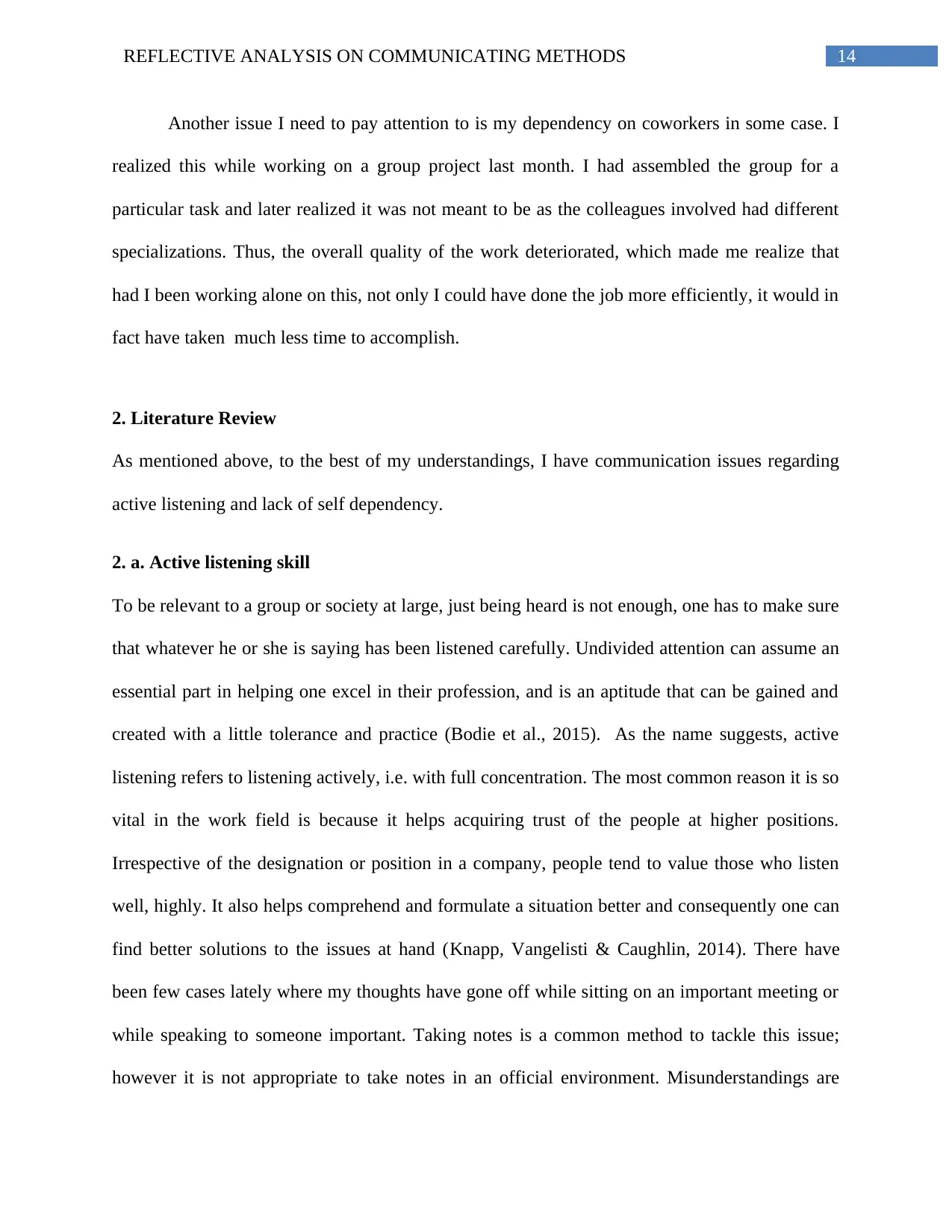
14REFLECTIVE ANALYSIS ON COMMUNICATING METHODS
Another issue I need to pay attention to is my dependency on coworkers in some case. I
realized this while working on a group project last month. I had assembled the group for a
particular task and later realized it was not meant to be as the colleagues involved had different
specializations. Thus, the overall quality of the work deteriorated, which made me realize that
had I been working alone on this, not only I could have done the job more efficiently, it would in
fact have taken much less time to accomplish.
2. Literature Review
As mentioned above, to the best of my understandings, I have communication issues regarding
active listening and lack of self dependency.
2. a. Active listening skill
To be relevant to a group or society at large, just being heard is not enough, one has to make sure
that whatever he or she is saying has been listened carefully. Undivided attention can assume an
essential part in helping one excel in their profession, and is an aptitude that can be gained and
created with a little tolerance and practice (Bodie et al., 2015). As the name suggests, active
listening refers to listening actively, i.e. with full concentration. The most common reason it is so
vital in the work field is because it helps acquiring trust of the people at higher positions.
Irrespective of the designation or position in a company, people tend to value those who listen
well, highly. It also helps comprehend and formulate a situation better and consequently one can
find better solutions to the issues at hand (Knapp, Vangelisti & Caughlin, 2014). There have
been few cases lately where my thoughts have gone off while sitting on an important meeting or
while speaking to someone important. Taking notes is a common method to tackle this issue;
however it is not appropriate to take notes in an official environment. Misunderstandings are
Another issue I need to pay attention to is my dependency on coworkers in some case. I
realized this while working on a group project last month. I had assembled the group for a
particular task and later realized it was not meant to be as the colleagues involved had different
specializations. Thus, the overall quality of the work deteriorated, which made me realize that
had I been working alone on this, not only I could have done the job more efficiently, it would in
fact have taken much less time to accomplish.
2. Literature Review
As mentioned above, to the best of my understandings, I have communication issues regarding
active listening and lack of self dependency.
2. a. Active listening skill
To be relevant to a group or society at large, just being heard is not enough, one has to make sure
that whatever he or she is saying has been listened carefully. Undivided attention can assume an
essential part in helping one excel in their profession, and is an aptitude that can be gained and
created with a little tolerance and practice (Bodie et al., 2015). As the name suggests, active
listening refers to listening actively, i.e. with full concentration. The most common reason it is so
vital in the work field is because it helps acquiring trust of the people at higher positions.
Irrespective of the designation or position in a company, people tend to value those who listen
well, highly. It also helps comprehend and formulate a situation better and consequently one can
find better solutions to the issues at hand (Knapp, Vangelisti & Caughlin, 2014). There have
been few cases lately where my thoughts have gone off while sitting on an important meeting or
while speaking to someone important. Taking notes is a common method to tackle this issue;
however it is not appropriate to take notes in an official environment. Misunderstandings are
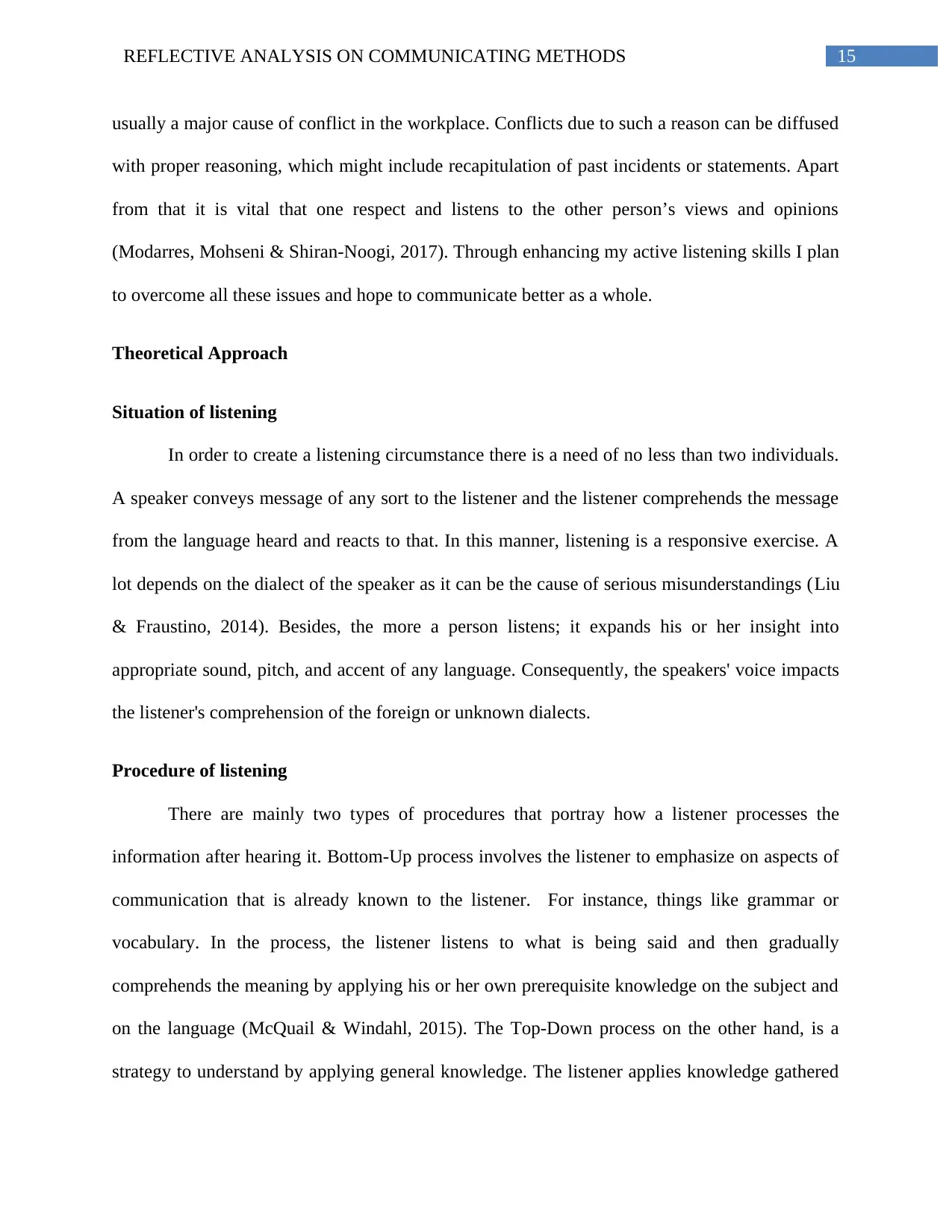
15REFLECTIVE ANALYSIS ON COMMUNICATING METHODS
usually a major cause of conflict in the workplace. Conflicts due to such a reason can be diffused
with proper reasoning, which might include recapitulation of past incidents or statements. Apart
from that it is vital that one respect and listens to the other person’s views and opinions
(Modarres, Mohseni & Shiran-Noogi, 2017). Through enhancing my active listening skills I plan
to overcome all these issues and hope to communicate better as a whole.
Theoretical Approach
Situation of listening
In order to create a listening circumstance there is a need of no less than two individuals.
A speaker conveys message of any sort to the listener and the listener comprehends the message
from the language heard and reacts to that. In this manner, listening is a responsive exercise. A
lot depends on the dialect of the speaker as it can be the cause of serious misunderstandings (Liu
& Fraustino, 2014). Besides, the more a person listens; it expands his or her insight into
appropriate sound, pitch, and accent of any language. Consequently, the speakers' voice impacts
the listener's comprehension of the foreign or unknown dialects.
Procedure of listening
There are mainly two types of procedures that portray how a listener processes the
information after hearing it. Bottom-Up process involves the listener to emphasize on aspects of
communication that is already known to the listener. For instance, things like grammar or
vocabulary. In the process, the listener listens to what is being said and then gradually
comprehends the meaning by applying his or her own prerequisite knowledge on the subject and
on the language (McQuail & Windahl, 2015). The Top-Down process on the other hand, is a
strategy to understand by applying general knowledge. The listener applies knowledge gathered
usually a major cause of conflict in the workplace. Conflicts due to such a reason can be diffused
with proper reasoning, which might include recapitulation of past incidents or statements. Apart
from that it is vital that one respect and listens to the other person’s views and opinions
(Modarres, Mohseni & Shiran-Noogi, 2017). Through enhancing my active listening skills I plan
to overcome all these issues and hope to communicate better as a whole.
Theoretical Approach
Situation of listening
In order to create a listening circumstance there is a need of no less than two individuals.
A speaker conveys message of any sort to the listener and the listener comprehends the message
from the language heard and reacts to that. In this manner, listening is a responsive exercise. A
lot depends on the dialect of the speaker as it can be the cause of serious misunderstandings (Liu
& Fraustino, 2014). Besides, the more a person listens; it expands his or her insight into
appropriate sound, pitch, and accent of any language. Consequently, the speakers' voice impacts
the listener's comprehension of the foreign or unknown dialects.
Procedure of listening
There are mainly two types of procedures that portray how a listener processes the
information after hearing it. Bottom-Up process involves the listener to emphasize on aspects of
communication that is already known to the listener. For instance, things like grammar or
vocabulary. In the process, the listener listens to what is being said and then gradually
comprehends the meaning by applying his or her own prerequisite knowledge on the subject and
on the language (McQuail & Windahl, 2015). The Top-Down process on the other hand, is a
strategy to understand by applying general knowledge. The listener applies knowledge gathered
Secure Best Marks with AI Grader
Need help grading? Try our AI Grader for instant feedback on your assignments.
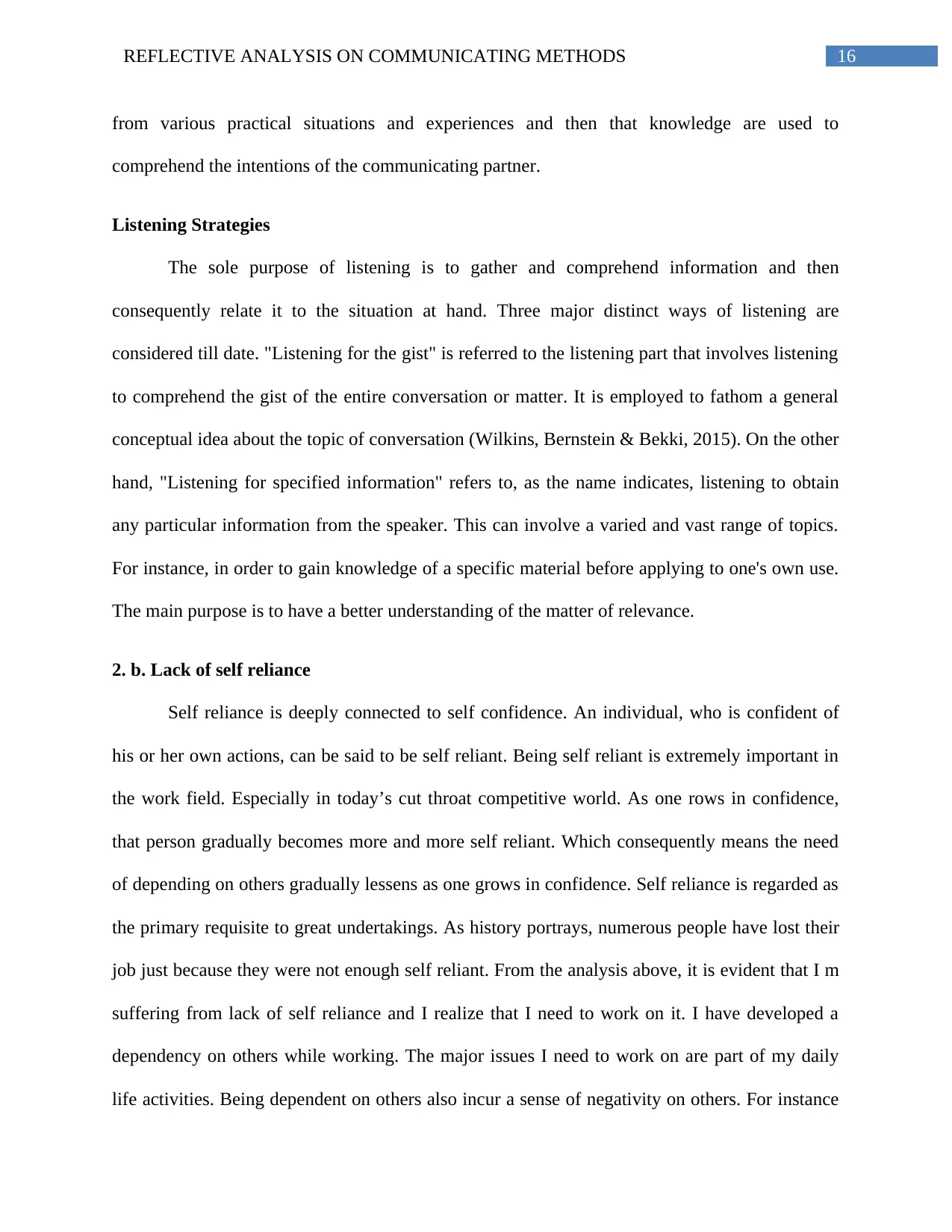
16REFLECTIVE ANALYSIS ON COMMUNICATING METHODS
from various practical situations and experiences and then that knowledge are used to
comprehend the intentions of the communicating partner.
Listening Strategies
The sole purpose of listening is to gather and comprehend information and then
consequently relate it to the situation at hand. Three major distinct ways of listening are
considered till date. "Listening for the gist" is referred to the listening part that involves listening
to comprehend the gist of the entire conversation or matter. It is employed to fathom a general
conceptual idea about the topic of conversation (Wilkins, Bernstein & Bekki, 2015). On the other
hand, "Listening for specified information" refers to, as the name indicates, listening to obtain
any particular information from the speaker. This can involve a varied and vast range of topics.
For instance, in order to gain knowledge of a specific material before applying to one's own use.
The main purpose is to have a better understanding of the matter of relevance.
2. b. Lack of self reliance
Self reliance is deeply connected to self confidence. An individual, who is confident of
his or her own actions, can be said to be self reliant. Being self reliant is extremely important in
the work field. Especially in today’s cut throat competitive world. As one rows in confidence,
that person gradually becomes more and more self reliant. Which consequently means the need
of depending on others gradually lessens as one grows in confidence. Self reliance is regarded as
the primary requisite to great undertakings. As history portrays, numerous people have lost their
job just because they were not enough self reliant. From the analysis above, it is evident that I m
suffering from lack of self reliance and I realize that I need to work on it. I have developed a
dependency on others while working. The major issues I need to work on are part of my daily
life activities. Being dependent on others also incur a sense of negativity on others. For instance
from various practical situations and experiences and then that knowledge are used to
comprehend the intentions of the communicating partner.
Listening Strategies
The sole purpose of listening is to gather and comprehend information and then
consequently relate it to the situation at hand. Three major distinct ways of listening are
considered till date. "Listening for the gist" is referred to the listening part that involves listening
to comprehend the gist of the entire conversation or matter. It is employed to fathom a general
conceptual idea about the topic of conversation (Wilkins, Bernstein & Bekki, 2015). On the other
hand, "Listening for specified information" refers to, as the name indicates, listening to obtain
any particular information from the speaker. This can involve a varied and vast range of topics.
For instance, in order to gain knowledge of a specific material before applying to one's own use.
The main purpose is to have a better understanding of the matter of relevance.
2. b. Lack of self reliance
Self reliance is deeply connected to self confidence. An individual, who is confident of
his or her own actions, can be said to be self reliant. Being self reliant is extremely important in
the work field. Especially in today’s cut throat competitive world. As one rows in confidence,
that person gradually becomes more and more self reliant. Which consequently means the need
of depending on others gradually lessens as one grows in confidence. Self reliance is regarded as
the primary requisite to great undertakings. As history portrays, numerous people have lost their
job just because they were not enough self reliant. From the analysis above, it is evident that I m
suffering from lack of self reliance and I realize that I need to work on it. I have developed a
dependency on others while working. The major issues I need to work on are part of my daily
life activities. Being dependent on others also incur a sense of negativity on others. For instance
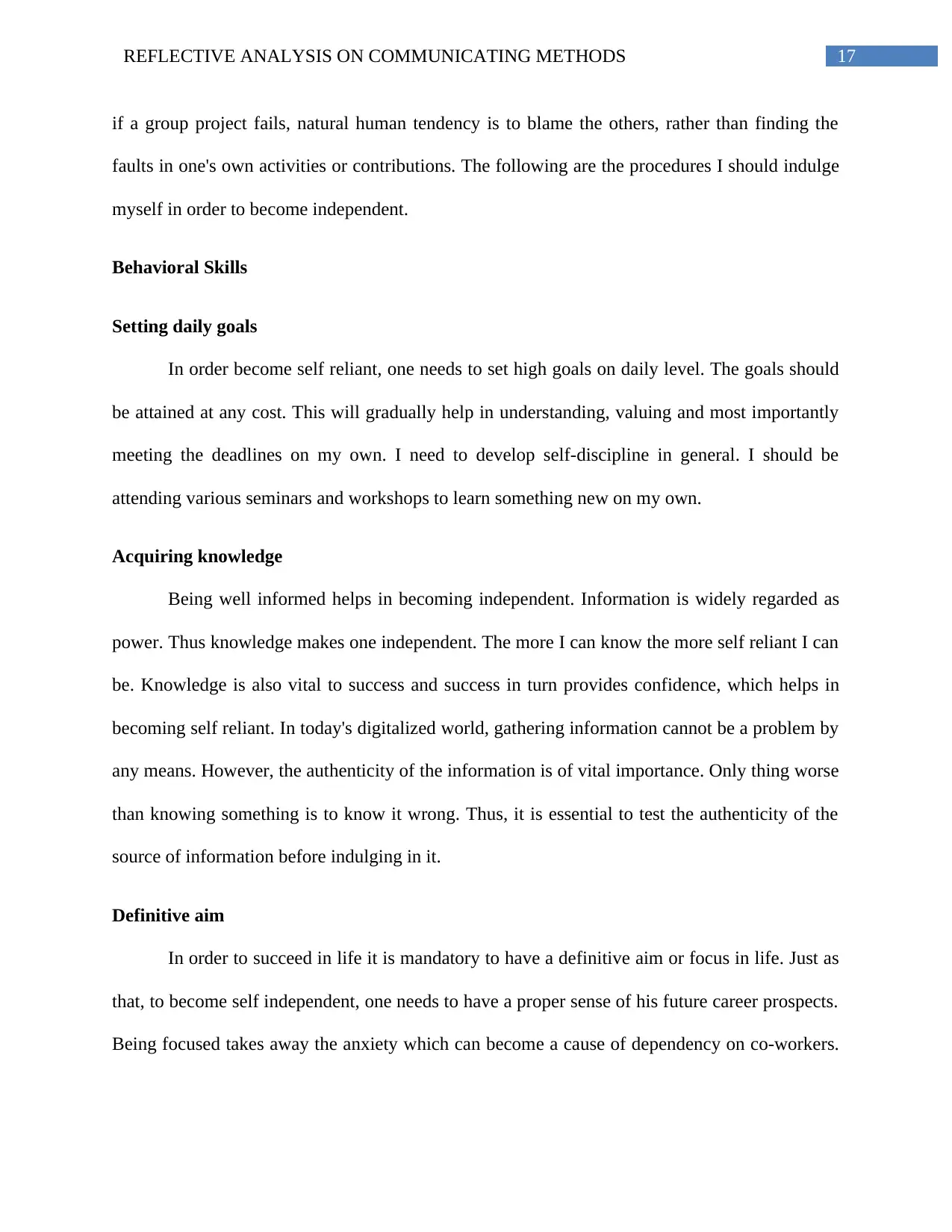
17REFLECTIVE ANALYSIS ON COMMUNICATING METHODS
if a group project fails, natural human tendency is to blame the others, rather than finding the
faults in one's own activities or contributions. The following are the procedures I should indulge
myself in order to become independent.
Behavioral Skills
Setting daily goals
In order become self reliant, one needs to set high goals on daily level. The goals should
be attained at any cost. This will gradually help in understanding, valuing and most importantly
meeting the deadlines on my own. I need to develop self-discipline in general. I should be
attending various seminars and workshops to learn something new on my own.
Acquiring knowledge
Being well informed helps in becoming independent. Information is widely regarded as
power. Thus knowledge makes one independent. The more I can know the more self reliant I can
be. Knowledge is also vital to success and success in turn provides confidence, which helps in
becoming self reliant. In today's digitalized world, gathering information cannot be a problem by
any means. However, the authenticity of the information is of vital importance. Only thing worse
than knowing something is to know it wrong. Thus, it is essential to test the authenticity of the
source of information before indulging in it.
Definitive aim
In order to succeed in life it is mandatory to have a definitive aim or focus in life. Just as
that, to become self independent, one needs to have a proper sense of his future career prospects.
Being focused takes away the anxiety which can become a cause of dependency on co-workers.
if a group project fails, natural human tendency is to blame the others, rather than finding the
faults in one's own activities or contributions. The following are the procedures I should indulge
myself in order to become independent.
Behavioral Skills
Setting daily goals
In order become self reliant, one needs to set high goals on daily level. The goals should
be attained at any cost. This will gradually help in understanding, valuing and most importantly
meeting the deadlines on my own. I need to develop self-discipline in general. I should be
attending various seminars and workshops to learn something new on my own.
Acquiring knowledge
Being well informed helps in becoming independent. Information is widely regarded as
power. Thus knowledge makes one independent. The more I can know the more self reliant I can
be. Knowledge is also vital to success and success in turn provides confidence, which helps in
becoming self reliant. In today's digitalized world, gathering information cannot be a problem by
any means. However, the authenticity of the information is of vital importance. Only thing worse
than knowing something is to know it wrong. Thus, it is essential to test the authenticity of the
source of information before indulging in it.
Definitive aim
In order to succeed in life it is mandatory to have a definitive aim or focus in life. Just as
that, to become self independent, one needs to have a proper sense of his future career prospects.
Being focused takes away the anxiety which can become a cause of dependency on co-workers.
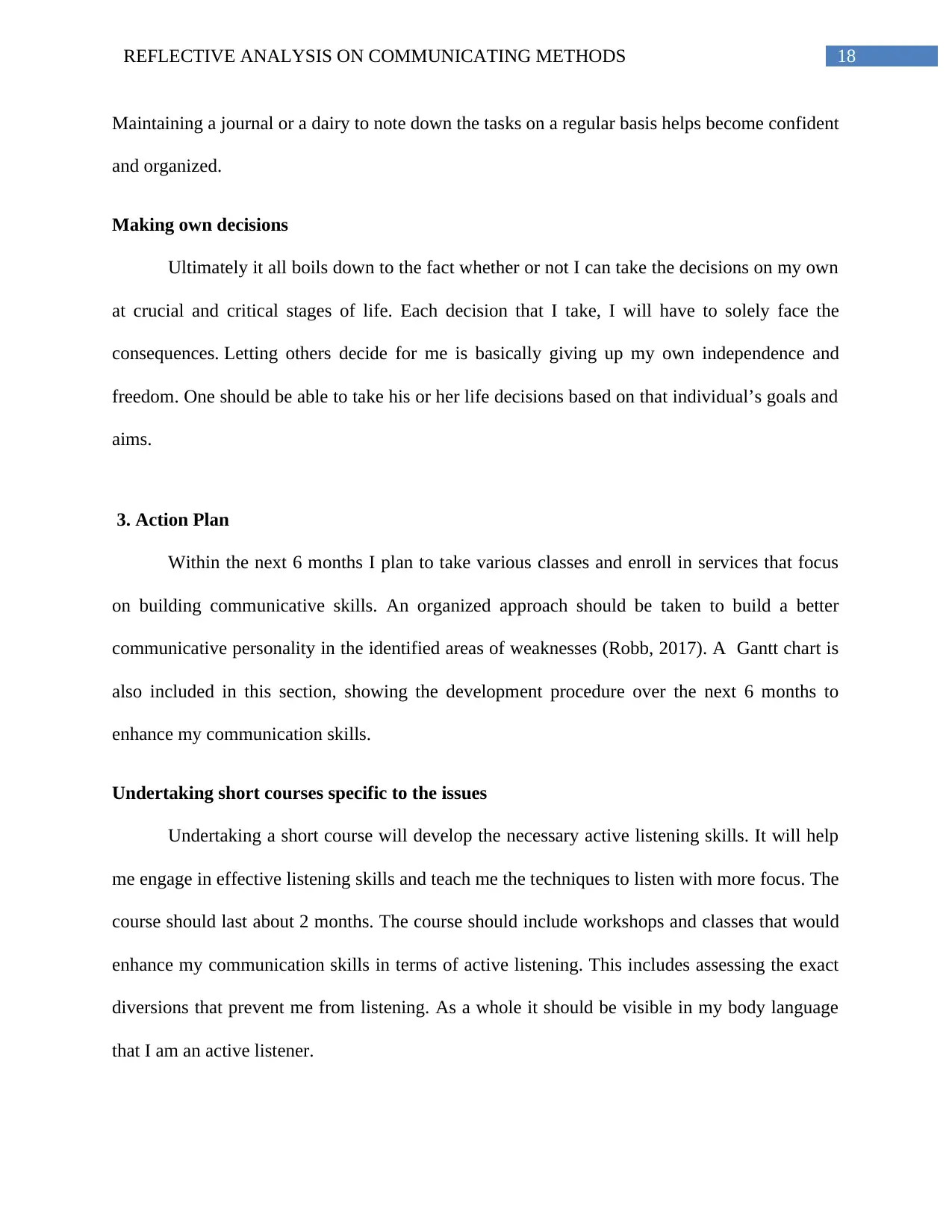
18REFLECTIVE ANALYSIS ON COMMUNICATING METHODS
Maintaining a journal or a dairy to note down the tasks on a regular basis helps become confident
and organized.
Making own decisions
Ultimately it all boils down to the fact whether or not I can take the decisions on my own
at crucial and critical stages of life. Each decision that I take, I will have to solely face the
consequences. Letting others decide for me is basically giving up my own independence and
freedom. One should be able to take his or her life decisions based on that individual’s goals and
aims.
3. Action Plan
Within the next 6 months I plan to take various classes and enroll in services that focus
on building communicative skills. An organized approach should be taken to build a better
communicative personality in the identified areas of weaknesses (Robb, 2017). A Gantt chart is
also included in this section, showing the development procedure over the next 6 months to
enhance my communication skills.
Undertaking short courses specific to the issues
Undertaking a short course will develop the necessary active listening skills. It will help
me engage in effective listening skills and teach me the techniques to listen with more focus. The
course should last about 2 months. The course should include workshops and classes that would
enhance my communication skills in terms of active listening. This includes assessing the exact
diversions that prevent me from listening. As a whole it should be visible in my body language
that I am an active listener.
Maintaining a journal or a dairy to note down the tasks on a regular basis helps become confident
and organized.
Making own decisions
Ultimately it all boils down to the fact whether or not I can take the decisions on my own
at crucial and critical stages of life. Each decision that I take, I will have to solely face the
consequences. Letting others decide for me is basically giving up my own independence and
freedom. One should be able to take his or her life decisions based on that individual’s goals and
aims.
3. Action Plan
Within the next 6 months I plan to take various classes and enroll in services that focus
on building communicative skills. An organized approach should be taken to build a better
communicative personality in the identified areas of weaknesses (Robb, 2017). A Gantt chart is
also included in this section, showing the development procedure over the next 6 months to
enhance my communication skills.
Undertaking short courses specific to the issues
Undertaking a short course will develop the necessary active listening skills. It will help
me engage in effective listening skills and teach me the techniques to listen with more focus. The
course should last about 2 months. The course should include workshops and classes that would
enhance my communication skills in terms of active listening. This includes assessing the exact
diversions that prevent me from listening. As a whole it should be visible in my body language
that I am an active listener.
Paraphrase This Document
Need a fresh take? Get an instant paraphrase of this document with our AI Paraphraser
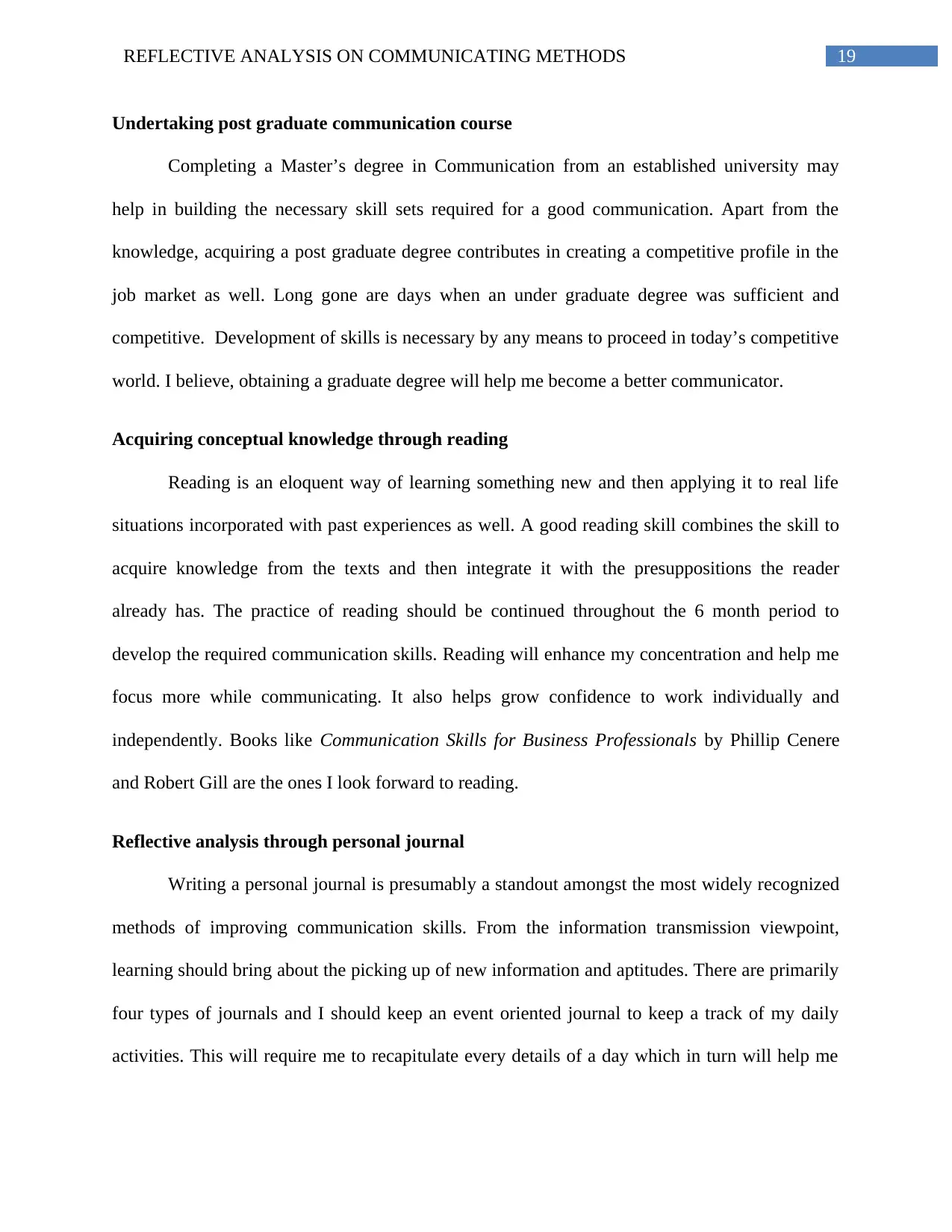
19REFLECTIVE ANALYSIS ON COMMUNICATING METHODS
Undertaking post graduate communication course
Completing a Master’s degree in Communication from an established university may
help in building the necessary skill sets required for a good communication. Apart from the
knowledge, acquiring a post graduate degree contributes in creating a competitive profile in the
job market as well. Long gone are days when an under graduate degree was sufficient and
competitive. Development of skills is necessary by any means to proceed in today’s competitive
world. I believe, obtaining a graduate degree will help me become a better communicator.
Acquiring conceptual knowledge through reading
Reading is an eloquent way of learning something new and then applying it to real life
situations incorporated with past experiences as well. A good reading skill combines the skill to
acquire knowledge from the texts and then integrate it with the presuppositions the reader
already has. The practice of reading should be continued throughout the 6 month period to
develop the required communication skills. Reading will enhance my concentration and help me
focus more while communicating. It also helps grow confidence to work individually and
independently. Books like Communication Skills for Business Professionals by Phillip Cenere
and Robert Gill are the ones I look forward to reading.
Reflective analysis through personal journal
Writing a personal journal is presumably a standout amongst the most widely recognized
methods of improving communication skills. From the information transmission viewpoint,
learning should bring about the picking up of new information and aptitudes. There are primarily
four types of journals and I should keep an event oriented journal to keep a track of my daily
activities. This will require me to recapitulate every details of a day which in turn will help me
Undertaking post graduate communication course
Completing a Master’s degree in Communication from an established university may
help in building the necessary skill sets required for a good communication. Apart from the
knowledge, acquiring a post graduate degree contributes in creating a competitive profile in the
job market as well. Long gone are days when an under graduate degree was sufficient and
competitive. Development of skills is necessary by any means to proceed in today’s competitive
world. I believe, obtaining a graduate degree will help me become a better communicator.
Acquiring conceptual knowledge through reading
Reading is an eloquent way of learning something new and then applying it to real life
situations incorporated with past experiences as well. A good reading skill combines the skill to
acquire knowledge from the texts and then integrate it with the presuppositions the reader
already has. The practice of reading should be continued throughout the 6 month period to
develop the required communication skills. Reading will enhance my concentration and help me
focus more while communicating. It also helps grow confidence to work individually and
independently. Books like Communication Skills for Business Professionals by Phillip Cenere
and Robert Gill are the ones I look forward to reading.
Reflective analysis through personal journal
Writing a personal journal is presumably a standout amongst the most widely recognized
methods of improving communication skills. From the information transmission viewpoint,
learning should bring about the picking up of new information and aptitudes. There are primarily
four types of journals and I should keep an event oriented journal to keep a track of my daily
activities. This will require me to recapitulate every details of a day which in turn will help me

20REFLECTIVE ANALYSIS ON COMMUNICATING METHODS
keep focused throughout the day. I should keep up with this technique beyond the initial six
months only.
A Gantt chart has been prepared below showing the timeline of my probation period.
Actions Week 1-5 Week 6-10 Week 11-15 Week 16-20 Week 21-24
Enrolling in short
courses
✓ ✓
Start applying in real
life situations
✓ ✓
Keep a personal
journal
✓ ✓ ✓ ✓ ✓
Reading ✓ ✓ ✓ ✓ ✓
Finding an appropriate
post graduation course
✓
keep focused throughout the day. I should keep up with this technique beyond the initial six
months only.
A Gantt chart has been prepared below showing the timeline of my probation period.
Actions Week 1-5 Week 6-10 Week 11-15 Week 16-20 Week 21-24
Enrolling in short
courses
✓ ✓
Start applying in real
life situations
✓ ✓
Keep a personal
journal
✓ ✓ ✓ ✓ ✓
Reading ✓ ✓ ✓ ✓ ✓
Finding an appropriate
post graduation course
✓
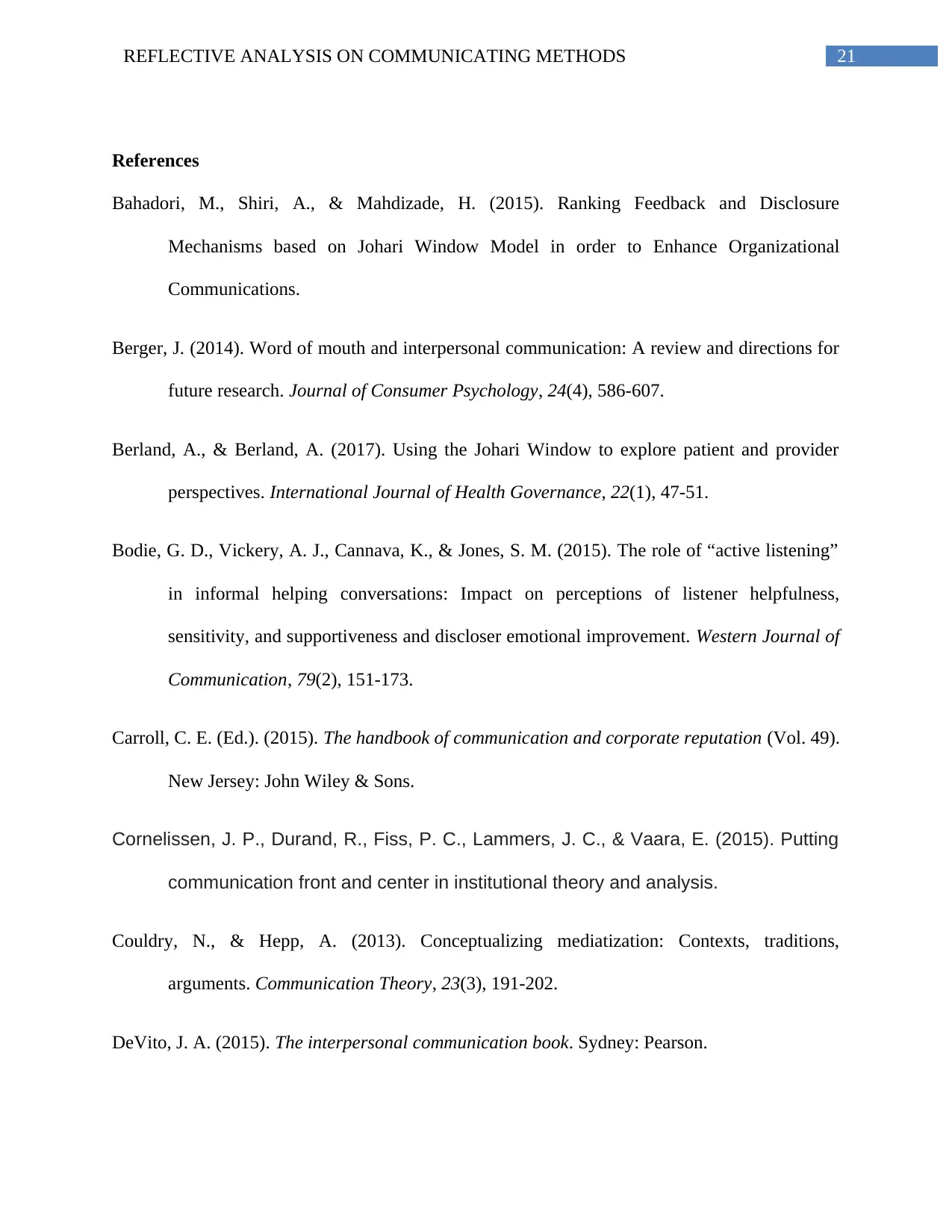
21REFLECTIVE ANALYSIS ON COMMUNICATING METHODS
References
Bahadori, M., Shiri, A., & Mahdizade, H. (2015). Ranking Feedback and Disclosure
Mechanisms based on Johari Window Model in order to Enhance Organizational
Communications.
Berger, J. (2014). Word of mouth and interpersonal communication: A review and directions for
future research. Journal of Consumer Psychology, 24(4), 586-607.
Berland, A., & Berland, A. (2017). Using the Johari Window to explore patient and provider
perspectives. International Journal of Health Governance, 22(1), 47-51.
Bodie, G. D., Vickery, A. J., Cannava, K., & Jones, S. M. (2015). The role of “active listening”
in informal helping conversations: Impact on perceptions of listener helpfulness,
sensitivity, and supportiveness and discloser emotional improvement. Western Journal of
Communication, 79(2), 151-173.
Carroll, C. E. (Ed.). (2015). The handbook of communication and corporate reputation (Vol. 49).
New Jersey: John Wiley & Sons.
Cornelissen, J. P., Durand, R., Fiss, P. C., Lammers, J. C., & Vaara, E. (2015). Putting
communication front and center in institutional theory and analysis.
Couldry, N., & Hepp, A. (2013). Conceptualizing mediatization: Contexts, traditions,
arguments. Communication Theory, 23(3), 191-202.
DeVito, J. A. (2015). The interpersonal communication book. Sydney: Pearson.
References
Bahadori, M., Shiri, A., & Mahdizade, H. (2015). Ranking Feedback and Disclosure
Mechanisms based on Johari Window Model in order to Enhance Organizational
Communications.
Berger, J. (2014). Word of mouth and interpersonal communication: A review and directions for
future research. Journal of Consumer Psychology, 24(4), 586-607.
Berland, A., & Berland, A. (2017). Using the Johari Window to explore patient and provider
perspectives. International Journal of Health Governance, 22(1), 47-51.
Bodie, G. D., Vickery, A. J., Cannava, K., & Jones, S. M. (2015). The role of “active listening”
in informal helping conversations: Impact on perceptions of listener helpfulness,
sensitivity, and supportiveness and discloser emotional improvement. Western Journal of
Communication, 79(2), 151-173.
Carroll, C. E. (Ed.). (2015). The handbook of communication and corporate reputation (Vol. 49).
New Jersey: John Wiley & Sons.
Cornelissen, J. P., Durand, R., Fiss, P. C., Lammers, J. C., & Vaara, E. (2015). Putting
communication front and center in institutional theory and analysis.
Couldry, N., & Hepp, A. (2013). Conceptualizing mediatization: Contexts, traditions,
arguments. Communication Theory, 23(3), 191-202.
DeVito, J. A. (2015). The interpersonal communication book. Sydney: Pearson.
Secure Best Marks with AI Grader
Need help grading? Try our AI Grader for instant feedback on your assignments.
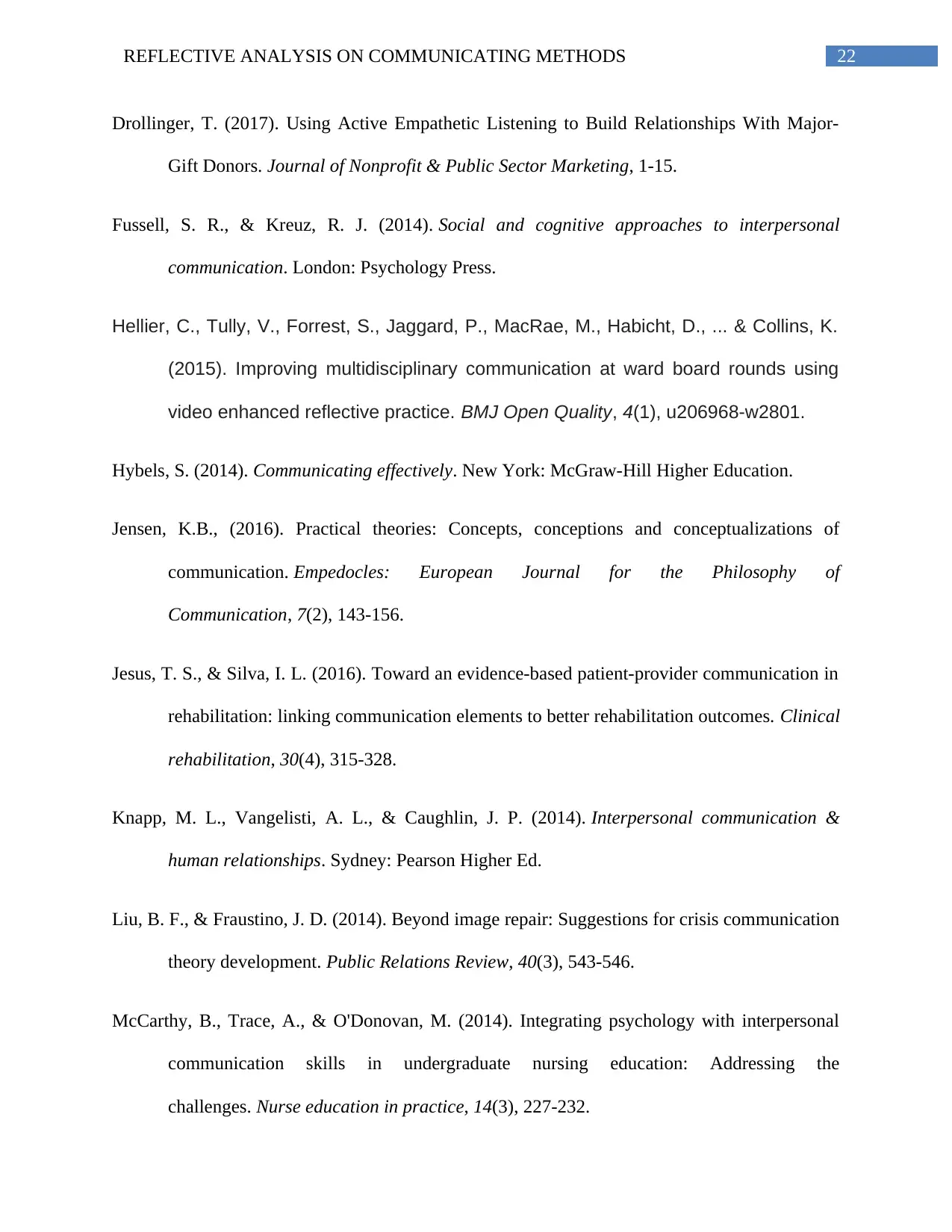
22REFLECTIVE ANALYSIS ON COMMUNICATING METHODS
Drollinger, T. (2017). Using Active Empathetic Listening to Build Relationships With Major-
Gift Donors. Journal of Nonprofit & Public Sector Marketing, 1-15.
Fussell, S. R., & Kreuz, R. J. (2014). Social and cognitive approaches to interpersonal
communication. London: Psychology Press.
Hellier, C., Tully, V., Forrest, S., Jaggard, P., MacRae, M., Habicht, D., ... & Collins, K.
(2015). Improving multidisciplinary communication at ward board rounds using
video enhanced reflective practice. BMJ Open Quality, 4(1), u206968-w2801.
Hybels, S. (2014). Communicating effectively. New York: McGraw-Hill Higher Education.
Jensen, K.B., (2016). Practical theories: Concepts, conceptions and conceptualizations of
communication. Empedocles: European Journal for the Philosophy of
Communication, 7(2), 143-156.
Jesus, T. S., & Silva, I. L. (2016). Toward an evidence-based patient-provider communication in
rehabilitation: linking communication elements to better rehabilitation outcomes. Clinical
rehabilitation, 30(4), 315-328.
Knapp, M. L., Vangelisti, A. L., & Caughlin, J. P. (2014). Interpersonal communication &
human relationships. Sydney: Pearson Higher Ed.
Liu, B. F., & Fraustino, J. D. (2014). Beyond image repair: Suggestions for crisis communication
theory development. Public Relations Review, 40(3), 543-546.
McCarthy, B., Trace, A., & O'Donovan, M. (2014). Integrating psychology with interpersonal
communication skills in undergraduate nursing education: Addressing the
challenges. Nurse education in practice, 14(3), 227-232.
Drollinger, T. (2017). Using Active Empathetic Listening to Build Relationships With Major-
Gift Donors. Journal of Nonprofit & Public Sector Marketing, 1-15.
Fussell, S. R., & Kreuz, R. J. (2014). Social and cognitive approaches to interpersonal
communication. London: Psychology Press.
Hellier, C., Tully, V., Forrest, S., Jaggard, P., MacRae, M., Habicht, D., ... & Collins, K.
(2015). Improving multidisciplinary communication at ward board rounds using
video enhanced reflective practice. BMJ Open Quality, 4(1), u206968-w2801.
Hybels, S. (2014). Communicating effectively. New York: McGraw-Hill Higher Education.
Jensen, K.B., (2016). Practical theories: Concepts, conceptions and conceptualizations of
communication. Empedocles: European Journal for the Philosophy of
Communication, 7(2), 143-156.
Jesus, T. S., & Silva, I. L. (2016). Toward an evidence-based patient-provider communication in
rehabilitation: linking communication elements to better rehabilitation outcomes. Clinical
rehabilitation, 30(4), 315-328.
Knapp, M. L., Vangelisti, A. L., & Caughlin, J. P. (2014). Interpersonal communication &
human relationships. Sydney: Pearson Higher Ed.
Liu, B. F., & Fraustino, J. D. (2014). Beyond image repair: Suggestions for crisis communication
theory development. Public Relations Review, 40(3), 543-546.
McCarthy, B., Trace, A., & O'Donovan, M. (2014). Integrating psychology with interpersonal
communication skills in undergraduate nursing education: Addressing the
challenges. Nurse education in practice, 14(3), 227-232.
1 out of 23
Related Documents
Your All-in-One AI-Powered Toolkit for Academic Success.
+13062052269
info@desklib.com
Available 24*7 on WhatsApp / Email
![[object Object]](/_next/static/media/star-bottom.7253800d.svg)
Unlock your academic potential
© 2024 | Zucol Services PVT LTD | All rights reserved.



